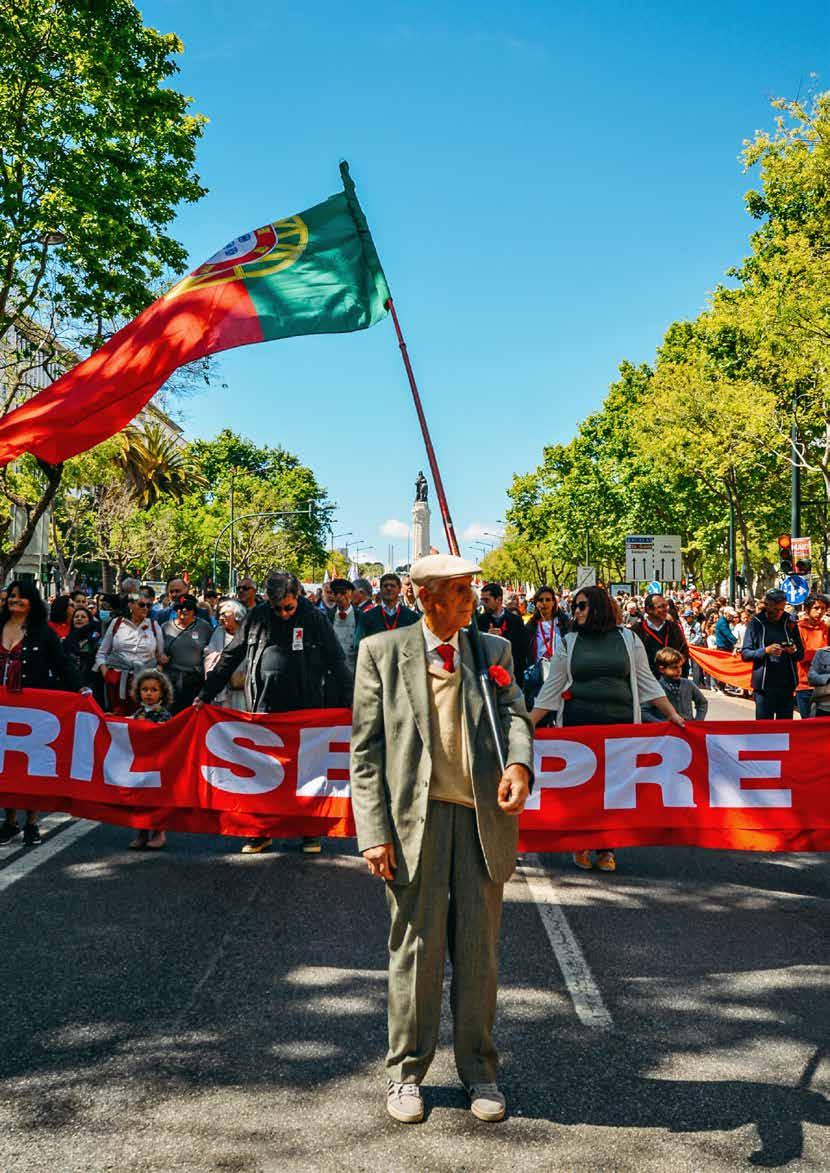
APRIL 2024 | EDITION 149 FREE A COMMUNITY MAGAZINE FOR THE ALGARVE










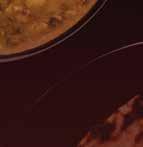


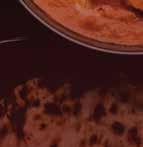


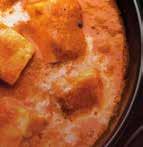

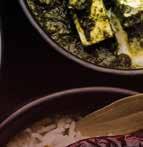










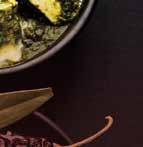












Largo Portas de Portugal 14, 8600-657 Lagos (Near Repsol garage o Avenida) www.delhidarbar.eu | 00351 282 762 249 | 00351 923 206 701 10% DISCOUNT ON TAKE AWAYS Plus a Poppadums and chutney tray ‘on the house’. Call to order: 00351 282 762 249 / 923 206 701 Delhi Darbar is a family owned Indian Restaurant where everything is made fresh, from scratch with our love and passion using high-quality ingredients! We are committed to providing all our customers a genuine Indian family dining experience with great service. UBER EATS & GLOVO DELIVERY SERVICE AVAILABLE
5,000 PRINTED COPIES
EDITORIAL
Sophie Sadler
sophie@tomorrowalgarve.com
+351 912 176 588
SALES
Tom Henshaw
tom@tomorrowalgarve.com
+351 919 918 733
DESIGN
Phil Harding phil@tomorrowalgarve.com
+351 916 606 226
FOLLOW
TomorrowAlgarve
@TomorrowAlgarve
www.tomorrowalgarve.com

ON THE COVER:
25 April, 2022 crowds hold carnation flowers in Avenida da Liberdade, Lisbon to mark the day the Portuguese gained freedom from dictatorship.
©️ Alexandre Rotenberg
AMI 6902
Editor's note
Dear readers of Tomorrow magazine,
This month, I am using this space to make an announcement. Due to the recent success of Tomorrow magazine, all rights to the magazine have been acquired by the Murdoch Media Group, who were looking for an outlet to report on the salacious gossip of the Algarve. We are very grateful for Rupert´s support. This April, Tom Henshaw and I are flying to LA on Rupert´s private jet to finalise the deal. I am looking forward to my hefty pay raise and meeting all the rich and famous people who visit the Algarve and drinking champagne with them all day. I will, therefore, be far too important to write these editor’s notes every month. So this will be the last time I will regale you with insightful thoughts about the coming month…..
APRIL FOOL!!!!!!
Did I get you??!!
Yes, this month’s magazine was released on April Fool’s Day, so it may inspire you to play a trick on someone you know. Although there are many intriguing theories, no one actually knows the origin of this day for pranksters, but it’s a fun way to start the month.
On the contrary to playing jokes, April 2024 is a significant month for Portugal and its people. It marks the 50-year anniversary of the Carnation Revolution when Portugal broke free from repression and censorship. These pages contain many interesting facts about this unique time in history, which gave us the country we know and love today.
Another celebration that will shortly take place is the Tomorrow Charity Summer Party, which will raise money for TACT (Tomorrow Algarve Charity Trust) at the Lagos Tivoli Hotel on Saturday, 1 June. There will be music from 5 EX and a tropical dress code to get the party started, so please register your interest at tact@tomorrowalgarve.com or +351 961 952 743. For the first time we are giving our readers the opportunity to choose which charities we support by a poll on our website, go to tomorrowalgarve.com/tomorrow-charity-summer-party-2024 to vote.
And I am fooling no one when I tell you that the following pages contain a fascinating insight into the range of characters, culture, events, art and culinary delights that have emerged from the freedom we enjoy in the Algarve today. So don’t be a fool! Get reading…..
From Sophie, Tom, Phil and the Tomorrow team
Contact us at our Lagos Marina O ce: +351 282 476 568
Email: enquiries@togofor-homes.com www.togofor-homes.com
SEDE: R. SENHORA LORETO LOTE 6 RC D PARIO CONVENTO 8600-683 LAGOS PERIODICIDADE: MENSAL . TIRAGEN: 6,500 TIPOGRAFIA: C/ AL MEDITERRÁNEO, 29, POLÍGONO
the website. Observação: os números de telefone presentes nesta publicação podem estar sujeitos a cobranças: números que começam por 2 chamada para rede fixa nacional e números começados por 9 chamada para rede móvel nacional.
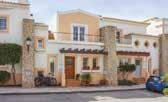
Budens
Ref: LG2219 €415.000
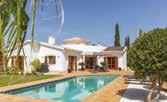

Ref: LG2220 REDUCED €795,000
DE SAN RAFAEL, 04230, HUÉRCAL DE ALMERÍA CIF: B04250056 Whilst we take every care to ensure details are correct the publisher will take no responsibility for errors or omissions. Where prices or dates are quoted they are correct at the time of publication and are subject to change. Links to third party websites are by no way an endorsement of the linked material and the publisher takes no responsibility for the content or security of any third party website. Unless specifically stated Tomorrow magazine does not endorse any product or service appearing in the directory, classified, editorial or display advertising featured on
RENTAL INVESTMENT TOWNHOUSE NEAR GOLF COURSE 3 127m² 2
FACING VILLA, PRIVATE POOL + ROOF TERRACE IN ECO-VILLAGE
PERFECT
SOUTH
Nr Silves
COUNTRY VILLA ON 2.3HA PLOT POOL + PANORAMIC VIEWS
3+1 162m² 3 3km 4 120m² 2 18km 750m 4km 11km
Nr
Burgau Ref: LG2159 €895.000
Skating
on Thin Ice
João Chalupa is not an ordinary guy! A roller hockey player, he made history in 2019 by beating a world record. In 2023, he completed an epic journey that had never been attempted before. This year, he is attempting an even greater challenge. This is all the more remarkable as he completes his adventures on inline skates.
WORDS Sophie Sadler
You might imagine that inline skating would be natural for roller hockey player João, but you would be wrong.
Roller hockey is played on roller skates with two front and two rear wheels and, most importantly, a break! When he first tried inline skating as a kid, he leaned forward to apply the brake, discovered it wasn’t there and face-planted! He didn’t try it again in a hurry.
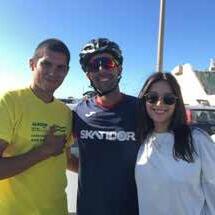
However, João’s passion for roller hockey, which began when he was five years old, continued. He plays for the Hóquei Clube Vasco da Gama de Sines, for which he trains three times a week. In 2019, while studying for a degree in Sports Science, he was flicking through his Instagram feed and saw a post about a Guinness World Record. “I just thought it would be cool to have a Guinness World Record, and it got me thinking.”
In his second year of university in Lisbon, he approached his favourite teacher and explained his goal. They came up with the idea of him becoming the hockey player to make the most touches of the ball with the stick in one minute. João trained every day for three months until he

felt ready to achieve his goal. Unfortunately, getting an adjudicator from the Guinness World Records to observe him would cost €5,000, which was beyond his budget. The permissible alternative was to use four or five people to judge his attempt. Amazingly, he achieved 513 touches in the 60 seconds. João sent the evidence to the committee and, after an anxious three-month wait, a certificate arrived confirming that he was now the holder of the world record.
João is clearly someone who likes a challenge, so when an aggressive inline skater friend lent João his skates, he decided to have another go with them. Once he had overcome the compulsion to tip his hips in order to break, he started to enjoy the experience of skating distances rather than being confined to a rink. It wasn’t long before he had set himself the challenge of doing a marathon on wheels and he conquered the 42 km distance in one day. He then decided to try 50 km
and ended up covering 82 km. So what did he do next: he tried to reach 100 km. João started to dream big. If he could achieve these other goals, why not skate the length of Portugal?
João decided to do some research and plan a suitable route that avoided dirt tracks and cobblestones. He managed to convince his girlfriend, Filipa, and a university classmate, Manuel, to go on his adventure with him so that he would have a backup car if anything went wrong and to help him on the steepest descents (remember, he has no way of breaking!).
I wanted to know how much training he needed to get fit for the challenge. “My girlfriend’s father found me a summer job in the factory where he worked to raise money for my trip. It was quite physical labour, so it got me fit, and then I skated every day.”
The journey began on the morning of 27 August from Caminha, Viana do Castelo. Accompanied by his parents on his first day, João managed to get to Porto, a distance of 110 km. Unfortunately, he

COMMUNITY 4 Tomorrow magazine - community magazine for the Algarve | www.tomorrowalgarve.com
João with Filipa and Manuel

had made a crucial error by wearing new skates that had not been broken in. They were hard and caused lots of blisters, which were incredibly painful. “We needed to get to Aveiro in two days in order to hire the car my girlfriend and friend would travel in. I needed to cover 200 kms in two days, so the pressure was on.” After the very first day, his feet were full of blisters. “The blisters burst and left holes where the boots put pressure. Whenever I put my skates on, I’d put on a cream to take my mind off the pain. It didn’t get much better, so I had to put it on all the time,” he remembers. There were several moments when he thought about giving up, or maybe taking a break for a day or two, but his ambition and desire to complete the challenge outweighed the pain.
João covered around 60 to 70 km a day. He leaned on the support car to slow down when the descents were steeper. When he decided to put a notice in the support car indicating that he was going to skate around Portugal, he started interacting with the people on the road. While many drivers honked and gave words of encouragement, others beeped in frustration, wanting to get past. “Every time I passed a cyclist, we always talked and swapped stories. That was the most beautiful part of the trip.”
Along the way, João passed through Figueira da Foz, São Pedro de Moel, Santa Cruz, Sintra, Belém, Quinta do Conde and Sines. Some nights were spent in the homes of family or friends they knew in those towns, and, when that wasn’t possible, they stayed overnight in campsites. “There were many threats of falling, some of them serious, like when I was going 40 kilometres an hour downhill and almost did the splits. I hurt my groin, but it wasn’t catastrophic; it went away,” he says.
The pains that just wouldn’t go away were those on his feet, but while going through Troia, he met another athlete who inspired him to keep going. He kept passing a cyclist, and, when he had to stop to turn his wheels, the boy would overtake him. They kept up this game of cat and

mouse until the third time João passed him. “I offered him food and water. At first, he refused, but I told him that ‘food is never refused’, and he accepted.” After chatting, he learned that his name was Gergely and that he had cycled 6,000 km from Slovenia. “We really bonded; it felt like we were two crazy adventurers.”
João reached Portimão on 7 September after 12 days and 798 kilometres of skating. “The end was a mix of feelings. I felt I could have gone further, but I knew rain was coming, so I needed to finish within the schedule. So I felt enormous relief and excitement.” Sure enough, on day 13 it started to rain hard.
He was happy that he could help his new Slovenian friend on his return home when he found that Gergely was sleeping on the street in Sines. “I managed to get him a shower at my hockey pavilion, which is right next to where he slept that night. He spent the day at McDonald’s so he could work. He did translations from Czech to English and earned enough to eat and refuel while travelling. His story really moved me and inspired me to do something similar,” he says.
So, if you think this is the end of the story, you are wrong. In February, João flew with a friend to Valencia. This was a training expedition to prepare for his next epic challenge – to skate from Barcelona to his home town of Sines, a total of 2,200 km. He completed the 250 km from Valencia to Alicante in two days, which was good preparation for the longer trip, including how to overcome challenges. This time, circumstances were not on his side. It rained on the first day and João had to stop after 10 km when he became sick. His friend took over and skated 75 km. On the second day, it was sunny, so they completed the rest of the distance despite being stopped by the police four times as he did not have permission to skate on the highways. Unperturbed, they would drive a couple of kilometres and then get back on the skates. Other than the police, he told me the people

and landscapes were incredible. “Every day was an adventure, and getting to know the roads in preparation for the longer trip was a good exercise.”
He is aiming to take on this challenge in July and anticipates it will take a month. João is looking for sponsors to fund this epic challenge, in particular the support car, so if this story inspires you and you would like to support his endeavours, then he would love to hear from you.
Athletes like João make this world more interesting. An adventurer who is not content to walk through life at a normal pace, he sets himself challenging goals that require superhuman strength and a mental strength that is truly admirable. And maybe this will mean we will see him skating into the record books again in the future.
www.facebook.com/joao.chalupa
www.instagram.com/joaojoycechalupa
João with his father also called João
COMMUNITY 5
João with Gergely
Creating a commotion in Portugal
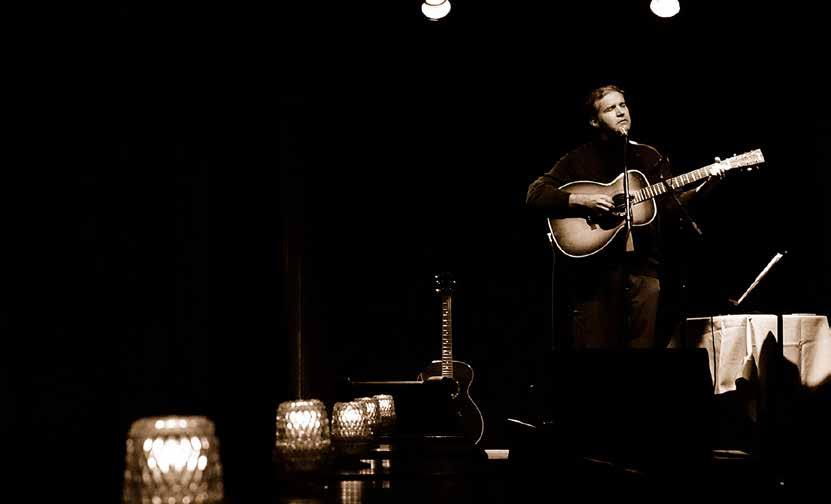
“I first visited Portugal in 1985 with my band, The Commotions. When we landed at the airport in Lisbon, they took us straight to our hotel in Estoril. There were thousands of fans there and our music seemed to be on every radio station. We never realised we were so popular in Portugal. We felt like The Beatles! I fell in love with the country, and I visit it every two years or so. I’ve often considered buying a place there, perhaps near Braga, which is a city I love.”
Lloyd Cole and his band shot to fame in 1984 with the release of their debut album Rattlesnakes. Lloyd’s handsome good looks and dress sense, together with the band’s poetic lyrics and striking melodies, catapulted him and fellow band members to international fame. Rattlesnakes is an album that, for many people, captures an extraordinary period in time. I asked Lloyd if, as a twenty-three-year-old, he had imagined what impact that album was about to have. “We certainly knew we’d produced something good. Looking back, I don’t think there are any weak tracks on it. Forty years on, I still think it’s a beautiful record.”
While the band ended just five years later, they have remained friends ever since, with Neil Clarke and Blair Cowan contributing to Lloyd’s latest album, On Pain. Released in June 2023, the new album marks a departure of sorts, with synthesisers at the fore instead of Lloyd’s more familiar. guitar-based
sound. Lloyd’s lyrics, vocals and melodies, however, remain unchanged and wonderful. Indeed, the new album has received rave reviews, with one critic describing it as “The sound of an artist who never stops evolving and experimenting”.
Seven concerts are scheduled in Portugal, with Loulé (4 May) being the one date in the Algarve. Lloyd will be performing solo with an acoustic, intimate set. I asked if an acoustic set would present any challenges in performing tracks from his new album. “I think two or three of the songs will work well,” said Lloyd. “The rest of the show will be songs from various parts of my career.” And it has been quite a career. Lloyd has 12 solo albums and three albums with The Commotions to draw upon, so there’s plenty of excellent material available to him. “I have about 30 songs prepared,” said Lloyd. “One of the things I enjoy about performing solo is that I can easily change the set to suit the evening and the audience, making each concert a unique experience.”
This year marks the 40th anniversary of the release of his debut album, Rattlesnakes. It has been a career that has taken him from his birthplace in Buxton, Derbyshire, to Lancashire, Glasgow, London, New York City, and his current home in Massachusetts, where he lives with his wife and two children. When he’s not touring or recording, Lloyd enjoys playing
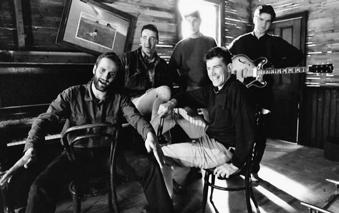

golf – with a single-figure handicap, he is an accomplished golfer – and cycling.
Lloyd is making some of the best music of his life and is looking forward to visiting Portugal again. “It will be me and my guitar and my songs,” he said. “Hopefully, we can create magical moments together in Portugal.” I don’t doubt for a second that will be the case, and Lloyd will continue making wonderful music to be enjoyed by audiences all over the world, including here in Portugal.
Vaughan Willmore speaks with Lloyd Cole about his new album and his love of Portugal.
WORDS Vaughan Willmore
www.lloydcole.com
© Doug Seymour 2008
© Chas Clark 1984
COMMUNITY 6 Tomorrow magazine - community magazine for the Algarve | www.tomorrowalgarve.com
© Jan Goedefroit 1986
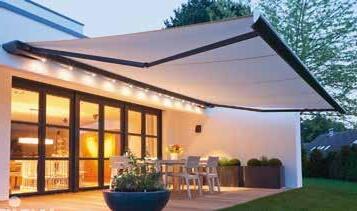






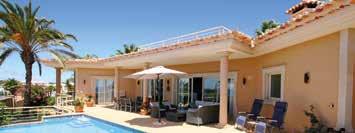




















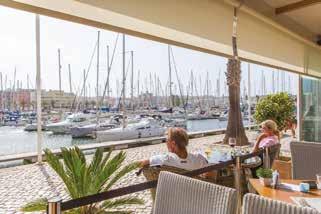

Email: sales@algarveaccommodation.co.uk Tel: (+351) 968 038 570 www.algarveaccommodation.co.uk RENT YOUR PROPERTY WITH CONFIDENCE *Based on a 12 month property management contract 50% DISCOUNT* on your 1st three months management fees With 26 years of experience offering quality holiday homes in Lagos, you and your property are in safe hands. +351 282 761 128 | www.quaylagos.pt Marina de Lagos, 8600-315 Lagos quaylagosmarina quaylagos Don’t forget! Succulent Sunday roasts and chef specials everyday… Located on the beautiful Marina de Lagos with free parking, kick back, relax and watch the world go by. We serve freshly prepared food from breakfast through to dinner everyday. A full varied menu along with daily specials and fresh fish means there is something for everyone, including vegetarian and vegan options and a gluten free menu. Our experienced bar tenders serve amazing drinks, from our cocktail, gin and wine lists including international and Portuguese wines not to forget a cool pint of Estrella served in a chilled glass plus our healthy smoothies. Pavlova, our best seller… We have had a kitchen refurb! Come and taste one of our delicious dishes with our fabulous new charcoal oven! toldos - awnings sun wind rain protection toldolanda info@toldolanda.com | www.toldolanda.com | 914 609 517

The Blue Pencil
From Censorship to Freedom
Censorship was part of Portuguese national culture until the Carnation Revolution in 1974. During Portugal’s 48 years of dictatorship, the blue pencil was one of the most symbolic instruments of censorship and oppression.
WORDS Sophie Sadler
On 11 April, 1933, a new constitution and a decree, published on the same day, established censorship for "periodicals, handbills, leaflets, posters and other publications, whenever in any of them political or social matters are covered”. By 14 May, 1936, the creation of newspapers was regulated and the Regulamento dos Serviços de Censura (Censorship Services Regulations) was adopted in November of the same year. Using the lápis azul (blue pencil, which came to be a symbol of censorship), city and district censors would strike out any text deemed unsuitable for publication. Now, in 2024, on the 50th anniversary of the Carnation Revolution, a movement has started to give the blue pencil a new meaning: freedom.
“My Freedom is Everyone’s” is being promoted by the Commission for the Commemoration of the 50th anniversary of 25 April, in partnership with the Gerador platform. “This project aims to contribute to greater knowledge about the dictatorship in Portugal, namely about censorship and its impacts, drawing attention to one of the most important achievements of April: freedom,” Maria Inácia Rezola, executive commissioner of the commemorations, announced in a statement sent to 7MARGENS. “The work of preserving memory and building the next 50 years of democracy needs everyone.”
The idea is to fill a small square the size of a traditional Portuguese tile with a drawing, forming a collective digital mural – Mural da Liberdade – to be publicised in April on the project’s digital page. In essence, the blue pencil, a symbol of censorship and oppression, will be transformed into a symbol of freedom.
In March, this collaborative initiative will be implemented in more than 200 schools
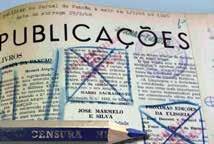

across the country from the second cycle to secondary education. Everyone can get involved via the project’s digital page, where the drawing can be created using a computer, tablet or mobile phone. It is also possible to join the campaign via social media, following the instructions described on the website and using the password #aminhaliberdadeedetodos.
Easter isn’t over – yet!
WORDS Rob Kean
It’s funny that even I, as an Anglican priest, have the tendency to feel that once Easter Sunday has finished, Easter is over, done and dusted as they say. But Easter isn’t just that one Sunday when chocolate eggs are consumed.
In actual fact, the church calendar marks a whole 50-day period of celebration called Easter-tide, and each Sunday during that time is supposed to be regarded as a ‘mini-Easter’ of sorts – perhaps we can use it as a reason to eat mini Easter eggs? Easter in the church ends on Pentecost Sunday, which is on 19 May this year.
And certainly, for me, Easter is a wonderful time of year that is full of new beginnings and fresh starts. It ties in with spring and new life all around us, and so it’s a time of hope, joy and often a time for our own personal renewal and growth.
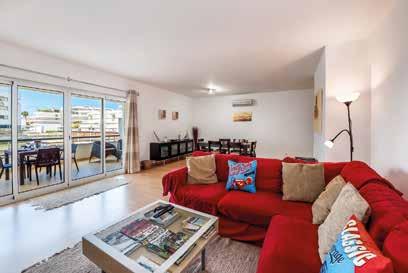
One of the things that has been resurrected (pun intended!) this year for us in Luz church is having some form of a Sunday school for the church, although we are calling it Sunday Club! We have started slowly on this, and it’s only happening on the last Sunday of each month in the salão, which is the parish-owned hall, just behind Luz church.
The idea is of course, to teach children about the many bible stories, traditions, and Christianity itself through fun activities and games. It’s run by our wonderful volunteers Debbie Schutte and Shirleen Horley, and primarily aimed at children from 5–12 years old, but if any other ages are interested, then I am sure they would be most welcome.
If you would like to register to come along to that, then please get in touch with me on +351 964 236 675 or email stvincentsalgarve.west@gmail.com
Have a wonderful Easter-tide!
gerador.eu/aminhaliberdadeedetodos-50anos25abril
Pre-Press Page from the "Noticias da Amadora" newspaper dated July 21/1970 with the cuts and corrections imposed by the Censorship Commission of Lisbon.
COMMUNITY 8 Tomorrow magazine - community magazine for the Algarve | www.tomorrowalgarve.com


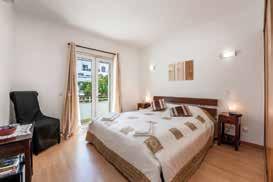

General Election 2024
And the winner is …
Portugal´s general election, held on 10 March, has produced losers but no obvious winner regarding who now governs the country and on what terms. Eight years of domination by the Socialist Party have come to an end. The populist right has surged in support. But what sort of government does the country now get?
WORDS James Plaskitt

The Socialists are the big losers. This almost certainly reflects the corruption allegations that were swirling around Antonio Costa’s government and which led to its early downfall, only two years after the previous election.
The main opposition, the conservative AD (PPD/PSD, CDS-PP and PPM coalition), failed to capitalise on the Socialists’ unpopularity. They ended up with broadly the same level of support they had two years ago when they were soundly defeated by the Socialists. This time, however, that same level of support has left them just ahead in terms of seats.
The populist right-wing Chega – founded only three years ago and led by former TV commentator Andre Ventura – has made dramatic progress, calling for Portugal to be ‘cleaned up’.
In the 230-member National Assembly, 116 seats are required to form a majority. No party is close. Therefore, the election will be followed
In summary, the election results are as follows, showing changes from the previous poll:
by negotiations to determine what sort of government can be assembled.
What are the options?
A right-wing coalition. The Conservatives and Chega could command a majority together. However, AD and PSD leader Luis Montenegro has repeatedly ruled out bringing Chega into government. He and Ventura were abusive about each other during the election campaign.
Furthermore, Portugal’s President, Marcelo Rebelo de Sousa, despite his constitutional obligation of neutrality, said during the campaign that he would prevent Chega from taking office.
A AD minority government. This alliance could only work if Chega agreed to support it without joining it, and there would undoubtedly be a heavy price for that. It could also work if the Socialists agreed not to vote against the government on crucial matters, such as the budget. Either arrangement would be inherently unstable.
A ‘grand coalition’. An arrangement between the two main parties either to enter government together, or to allow the other to do so on an alternating basis. There is no precedent for this in the post-1974 Republic. There could be strong public objection, especially to seeing the Socialists continue in office in any form after such a clear public rejection. Chega – loathed by both – could be the principal beneficiary of such an arrangement, as it would become the only effective alternative.
Another election. If negotiations end in deadlock or if a new government immediately runs into trouble with votes in the Assembly, either the parties, the President of the Republic, or both could call for a fresh election. The risk would be a very similar result, leaving the political deadlock firmly in place.
The election has produced the most problematic result the country has seen since the Republic came into being after the 1974 revolution. Fifty years of smooth oscillation between centre-right or centre-left coalitions has come to an end. Portugal’s political leaders have been given the formidable challenge of now making the public’s choice work – somehow.
James Plaskitt is a retired politician who was a member of the British Parliament from 1997 until 2010. He now lives in the Algarve.
AD (Conservative) PS (Socialist) Chega (‘Enough’) LI (Liberal) Left Bloc CDU (Communist) PAN (Ecologist) 29.5 28.7 18.1 5.1 4.5 3.3 1.6 2024 29.1 41.4 7.2 4.9 4.4 4.3 1.9 2022 % vote 79 77 48 8 5 4 1 2024 77 120 12 8 5 6 1 2022 Seats COMMUNITY 10 Tomorrow magazine - community magazine for the Algarve | www.tomorrowalgarve.com
Luis Montenegro, leader of AD coalition and PSD © European People's Party
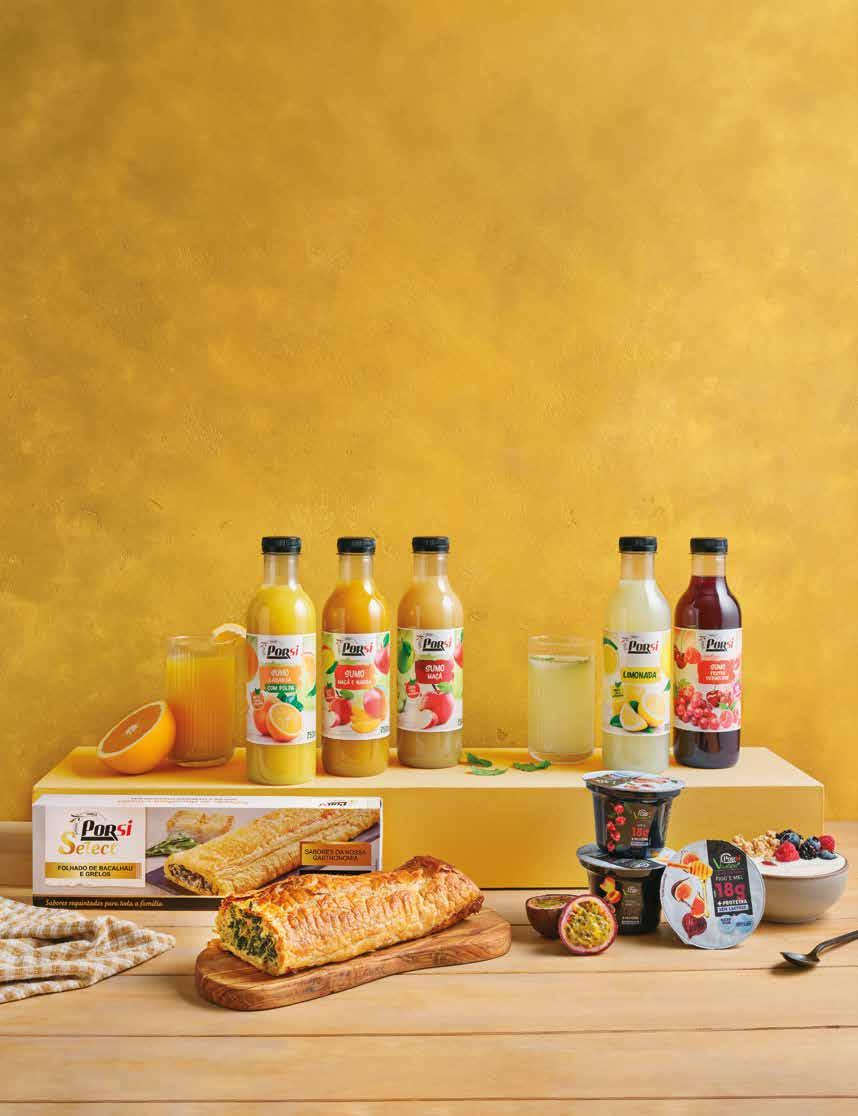
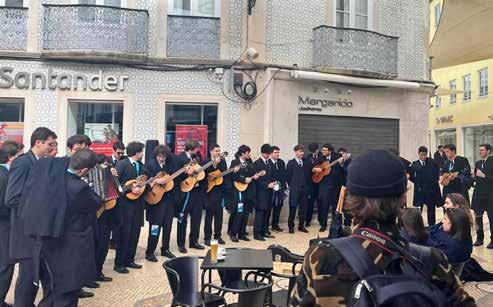
The Battle of the Tunas
The Tuna, not to be confused with the fish, has been a tradition in Portuguese and Spanish universities for centuries. Groups of students and academics still come together to sing, dance, and play music to preserve this historic tradition, which has been a vital part of academic life across the Iberian peninsula since the 13th century.
WORDS Luka Alexander PHOTOGRAPHY Luka Alexander and Jasmijn dos Santos
The academic tradition is believed to have started in Spain, where students would serenade villagers in a bid to earn money for food. The idea swept across to Portugal, where it became a staple in many universities as a way to have fun and earn money at the same time.
According to legend, the name Tuna is believed to have come from the King of Tunis, who was known to walk the streets playing instruments and partying with his loyal subjects. Whilst modern-day Tuna groups aren't out partying for money, students still keep the Tuna tradition alive, playing at events and even competing with other Tuna groups in a bid to become the champion Tuna.
Last month Versus Tuna from the University of the Algarve in Faro hosted the 23rd International Festival of Academic Tunas, known as Fartuna, to pay homage to the city of Faro. The two-day event hosted visiting Tunas as they went head to head, competing to take home the title of Melhor Tuna (the Best Tuna). In true traditional style, groups from the Azores, Coimbra, Porto and Seville in Spain hit the streets of Faro's downtown to serenade passers-by and pull out their best material to impress the judges from Versus Tuna.
Dressed in traditional costume, which are similar to a formal suit with petticoat breeches, the dress is completed with arguably the most important garment of the Tuna, the capa. The loose-fitting cloak, symbolic of the Tuna tradition and unique to each university, is adorned
with numerous badges, each representing an important part of the Tuna's academic life. The badge, known as a shield or escudo, starts with the emblem of the university, followed by the faculty, country flag and, often, the flag of the European Union. Various other badges representing home towns, cities, different countries, and messages of affection from loved ones, are gifted to the Tuna by their friends, families, and partners. In times gone by, the capa was used as a way to avoid punishments for busking by the police, which was frowned upon in medieval Portugal.
Likewise, the Spanish counterpart of the Portuguese capa is decorated with multicoloured ribbons, gifted by mothers, friends, and significant others. In the words of D. Martinez Pinto and M. Menéndez Vigo from the University of Santiago de Compostela, “Every ribbon that decorates my cloak, keeps a piece of heart.”
As a complete novice in the world of Portugal´s academia, I sat down with Pedro, a second-year freshman in Versus Tuna, to learn a little more. Pedro entered the Tuna two-and-half-years ago in a rather unusual way. Pedro explained, “When I got into university, one of our hazing traditions (a light-hearted voluntary team-building exercise between older and younger students) was to auction the freshmen to different majors or groups within the university. I ended up being “sold” to Versus Tuna and spent the evenings with them being introduced to their music. I had never played an instrument, but I had always had an interest in it, so I took the opportunity to join the Tuna in the hopes of learning an instrument during our meet-ups.”
Pedro became accustomed to Tuna life, making new friends and learning how to play the cavaquinho – the Portuguese guitar. It's the participation in festivals up and down the country and even abroad that he enjoys as well as the public recognition. “I like the camaraderie and the relationships you make within the Tuna. It's very common for us to get recognised when we go out as a group to the academic nightlife of Faro, and we always end up meeting tons of new people.

COMMUNITY 12 Tomorrow magazine - community magazine for the Algarve | www.tomorrowalgarve.com
Coimbra Tuna 'Estudantina de Coimbra' 1888 (public domain via Wiki)
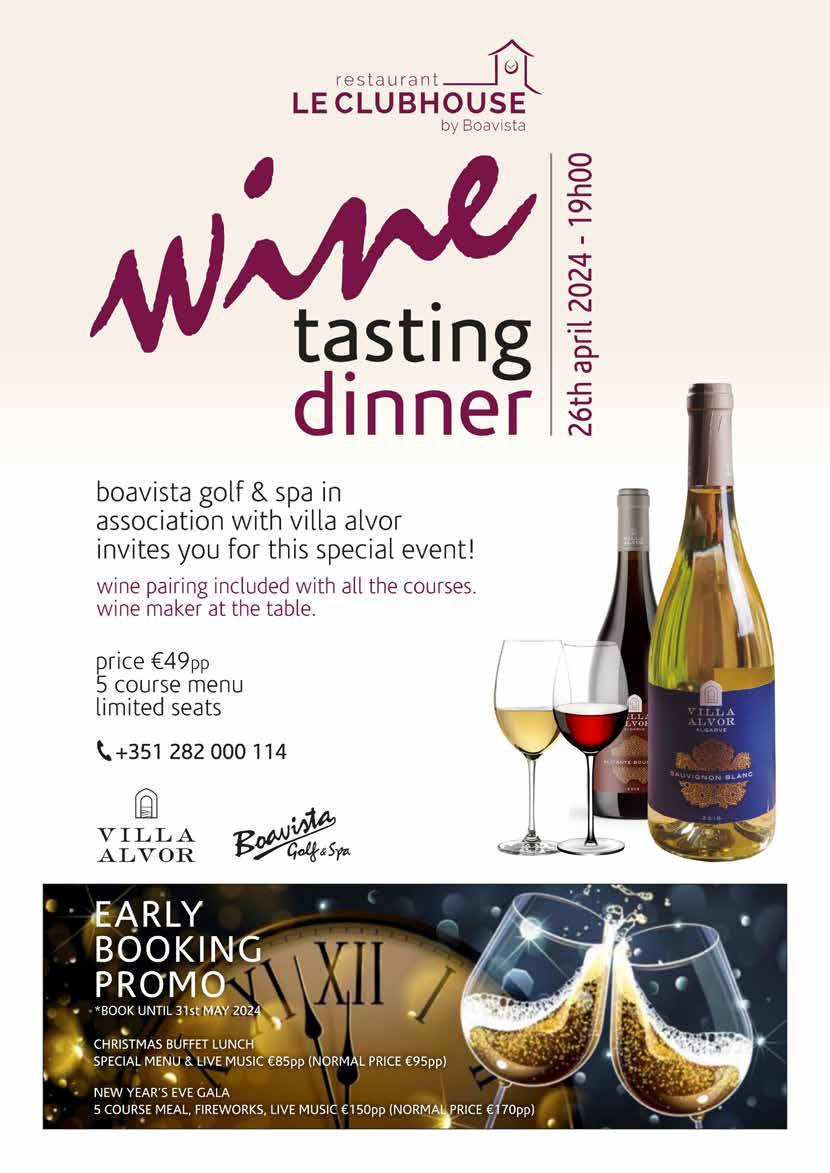
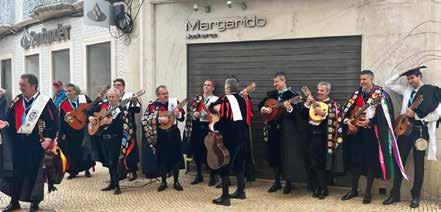
One of my favourite memories was when we were in an Irish Pub in Faro and we ended up being dragged on stage and staying there for the rest of the night with customers buying us beers and talking to us about our group.”
I marvelled at the vast array of badges sewn onto Pedro's cloak. When I asked which badge was his favourite, he pointed to a comical slur, which I am unable to repeat here. The Tuna are known for their love of a drink and a joke and it’s this jolly nature which makes the Tuna unique: a mix of showmanship and musical talent combined with camaraderie and light-hearted humour among friends and revellers.
As Pedro returned to his duties as festival barman, I took cover under an umbrella outside one of the many quintessential cafés in downtown Faro where the Tuna competition would be judged. The sound of guitars and drums echoed through the cobbled alleyways as the first Tuna group approached us enthusiastically despite the torrential downpour of rain. Led by their banner, the Tuna of the Azores broke out into song and dance, egging the crowd on to join in with several well-known popular songs and self-created musical numbers. Known officially as the Tuna Universitas Scientiarum Agrariarum, the group soon drew a crowd of other Tunas, locals, and curious tourists interested in learning more about this academic festival. After dedicating a song to a mother and her baby watching from the shelter of the café (to the delight of onlookers), the Tuna of the Azores took their bow before marching off into the distance as we awaited the next contestants.
The ever-flamboyant Tuna of Seville, known as La Tuna de Magisterio de Sevilla, merrily pranced their way towards the judging table before marching and countermarching to the beat of their music. Dressed in colourful cloaks, with their ornate ribbons distinguishing themselves from their Portuguese counterparts, the Spaniards took advantage of their heritage by mixing a collection of traditional melodies and modern songs, swinging and dancing in unison, bringing a party-like atmosphere to the now bustling alleyway. Consisting of mainly older Tunas, the loud, extravagant serenade ended in true Spanish style, with an Olé and a coffee and a cigarette before heading off for their next performance by the marina.
The University of Coimbra is one of the oldest universities in the world and the oldest in Portugal after its foundation by none other than my ancestor, King Denis I of Portugal, in 1290. The aptly named Imperial Tuna Académica da Faculdade de Farmácia da Universidade de Coimbra or Imperial TAFFUC for short, was led by the regal-looking purple banner. Undeterred by their Spanish competitors, the group burst into song with tambourines and danced in perfect unison as the crowd clapped along and ended in rapturous applause for Portugal's historic university.
With a selection of instrumental numbers and solo spots, the Tunas from Coimbra ended their performance in true Portuguese style, toasting one another with a glass of beer, which I assume wasn't the first one of the day.
The final Tuna of the competition was the Tuna Académica do Instituto Superior de Engenharia do Porto, who took a somewhat different approach to the typical Portuguese guitar. Playing a Russian-inspired melody on a balalaika, onlookers jeered as two tambourists mimicked the prisyadka dance, which was well received by both the crowd and the judges. As the tambourists competed against each other, the banner bearer swirled and juggled the Tuna banner in time with the sound of guitars, flutes, and tambourines, giving any professional juggler a run for their money.
As the competition came to a close, the streets of downtown Faro returned to their usual tranquil state, and the judges headed off to evaluate their results, leaving the Tunas to prepare for a night of song and dance on stage at the Conservatório Regional do Algarve. The evening event showcased each Tuna and the eagerly awaited results of the 23rd International Tuna Festival competition were announced.
With eight categories up for grabs, the Tuna of the Azores walked away with the title of best instrumental, whilst the Tuna of Porto won in two categories for best serenade and best pasacalles (a musical form that originated in early 17thcentury Spain). The Tuna of Coimbra won in four categories: the best banner, the best tambourinist, the best soloist, and the best Tuna performance. However, the winner of the best Tuna in spirit, or the Melhor Tuna, was the Spanish La Tuna de Magisterio de Sevilla, who returned home victorious to Spain.
My day with the Tunas showed me another aspect of the cultural life of an Iberian student. Along with the costumes, dances, comedy, and varying musical abilities, it is the brotherhood it creates and the lifelong friends made along the way that make the Tuna successful. So, if you see a Tuna group, why not raise a glass for the students and congratulate them on their studies? Who knows, they might even play for you, not for money but for their love of this ancient tradition and friendship.
 Tuna de Magisterio de Sevilla
Tuna de Magisterio de Sevilla
COMMUNITY 14 Tomorrow magazine - community magazine for the Algarve | www.tomorrowalgarve.com
Tuna Universitas Scientiarum Agrariarum

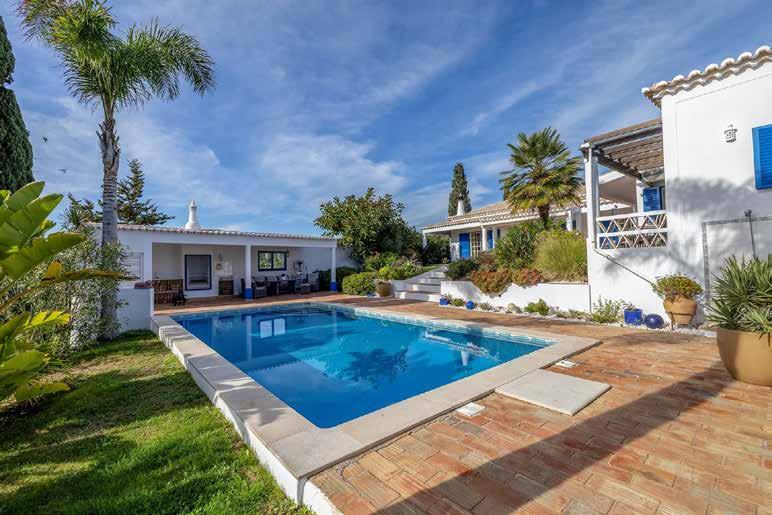

www.marcelaproperties.com info@marcelaproperties.com 00351 282 788 977 VISIT OUR SHOPS IN: LAGOS CENTER - PRAIA DA LUZ - ALJEZUR RURAL VILLA WITH POOL, STABLES, PADDOCK AND RIDING ARENA - BENSAFRIM AMI 1538 (Call cost for national landline) 3 : 3 : 191 m² | Ref.: C3889
Reader’s Suggestions
Our readers’ top tips for making the most of the Algarve. Send your suggestions for next month by getting in touch with our editor, Sophie Sadler: sophie@tomorrowalgarve.com
From: Ulli Schmeling
Subject: The Sustainability Group of Albufeira
As a “part-time Albuferian”, I often get upset about the littered environment, especially beaches. I have started collecting trash whenever possible and disposing of it properly.
A month ago, I founded The Sustainability Group of Albufeira Social on Facebook. On a daily basis, I seek to post as much as I’m able to find on any sustainability topics – local issues and or global ones – to increase topic awareness and responsibility, especially among expats and tourists. Everyone is invited to do what they can. Better to take small steps than none at all. I believe we should leave the coming generations a world worth living in – and preserve the beautiful Algarve. So far, we have 43
supporters mainly from the Albufeira Social & Networking Group. I post in both groups where possible and encourage the supporters to engage and post themselves (sustainable events, any topic related to this, etc.).
I found a superb collaborator in João Justo dos Santos from Before e After Ocean Preservation. João organises monthly beach clean-ups in Albufeira and was active on this before I started the group. (João and his team collected 21 kg of trash on 18 February 2024.)
Please join our group.
ullisartgallery.blogspot.com
WhatsApp: +49 179 2963804
 From: Quinta Art Collective
From: Quinta Art Collective
Subject: Andrea
Quinta Art Collective was formed by five artists – five women, five friends – in a bid to support each other and bring our artwork to a larger audience through collaborative events and the usual exposition route.
It’s been an exciting few years and we have exhibited in a number of interesting venues. We have also featured on Channel 4’s New Life in the Sun. We are active on social media and have, over the last couple of years, become reasonably well known in the Algarve.
Each artist exhibits alone and as part of Quinta Art Collective. We each have very different disciplines, which range from fine art, sculpture, fibre art, portraiture and contemporary mosaic/mixed media. This mix is unique and enables us to appeal to a wide audience.
We try to bring art to a wider audience through collaborations, pop-ups and workshops. Later this year, we are looking to do a workshop at Estrella Yoga, which will cover painting, weaving, mosaics and drawing. This workshop will enable people from the local area to come and experience new things and learn new skills. We will also be exhibiting in the beautiful Republica 14 in Olhão in June. Jessica Dunn will be the Artist of the Month in April at Quadro. As part of a series of collaborations, Andrea B Designs is currently displaying work at the new hair salon in Almancil B HairDesigns.
quintaartcollective.com/about-us www.facebook.com/QuintaArtCollective
Instagram: Quinta_art_Collective
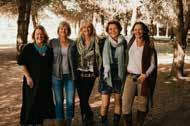
From: Jan Felton
Subject: Women of Loulé
I took over the running of Women of Loulé last August and our community is going from strength to strength every month. We now have over 1500 members. Our members work together to provide practical, emotional, professional and social support to one another, and to support their community.
We’re currently running first aid/ambulance callers training courses for people to attend in the area and the proceeds raised from the sessions are given to São Brás fire station to support the volunteer bombeiros
We have arranged a fundraising event on 11 May at Limitezero in Spain to do a sponsored zip wire. We are working with Kiss FM, local magazines and national newspapers to raise as much money as possible for the volunteer Bombeiros and Alerta, and to highlight the work they do. I was keen to do this event as I was so surprised at the lack of knowledge on how the firefighters work in the Algarve and how 755 are volunteers and not paid.
We also work with female business owners to provide support and workshops for members to ensure their businesses are known about and flourish. Our members are from all over the world and aren’t just expats, as we also have a large number of Portuguese/Algarvian women in our group.
Our page provides a safe environment for all women in the area, allowing us to network on both professional and social levels.
I’d love for you to mention our page and what we offer so anyone who hasn’t heard of us or is new to the Algarve can reach out and join our community.
Jan Felton +447759258881
info@womenofloule.com

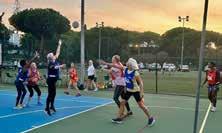
COMMUNITY 16 Tomorrow magazine - community magazine for the Algarve | www.tomorrowalgarve.com

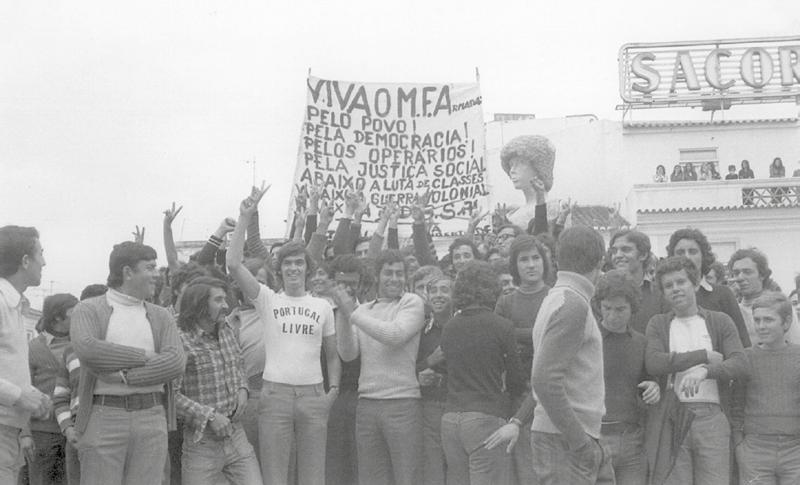
The Algarve and 25 April 1974
On the 50th anniversary of the Carnation Revolution, an investigation into the days after the political power shifted in the Algarve.
The 25 of April 1974, also known as the Revolução dos Cravos (Carnation Revolution), is a public holiday in Portugal that celebrates the day when the dictatorial fascist regime known as Estado Novo was overthrown. The Movimento das Forças Armadas (MFA) carried out the military coup. The uprising occurred in Lisbon and was undertaken with almost no violence or bloodshed.
The Carnation Revolution got its name from the carnations placed in the muzzles of guns and on the soldiers’ uniforms, which were given to them by the crowds. A combination of factors led to the uprising: discontent with the Portuguese colonial war in Africa, a lack of freedom and rights, and concerns about Portugal’s slow development.
Before 25 April 1974, Portugal experienced repression, hunger, misery, social injustice, labour exploitation, inequality for women, lack of opportunity for non-privileged groups, death and suffering due to the war in the Portuguese colonies in Africa, large-scale emigration, and widespread illiteracy, particularly in rural areas. Many people and groups, particularly those that defended the rights of others, such as the Portuguese Communist Party and the military, suffered years of fighting and repression. During this period, the dictatorial regime, using its police, the Polícia Internacional e de Defesa do Estado (PIDE), was responsible for suppressing any resistance, often using extreme force, imprisonment and murder. Humberto da Silva

Delgado was an example of a martyr for the opposition, a man who gave the people hope to believe that Portugal would once again be free from dictatorship. Sadly, he was murdered by the PIDE in Spain on 13 February 1965.
However, under Estado Novo, Portugal benefited from the creation of modern urbanisations, a network of primary schools, and cultural icons like the Galo de Barcelos (the popular rooster symbol). The Marchas Populares were the creation of António Ferro, from the Secretariado da Propaganda Nacional (SPN) and there was a focus on traditional values. There was more gold in the state banks, and Portugal’s GDP grew from 1950 to 1970 at an average annual rate of 5.7%. But, by the end of the regime, Portugal still had the lowest per capita income and the lowest literacy rate in Western Europe.
After the revolution, Portugal benefited from greater freedom with the acquisition of civil and working rights, the building of a democratic regime, the Movimentos Democráticos, and the creation of workers’ initiatives. However, there were also negatives like the expropriation of private property and decolonisation, with the return of large groups of Portuguese from the ex-African colonies (many having no money or belongings). Certain groups, such as the Forças Populares 25 de Abrill (FP 25), used terrorist measures to enforce their ideals.
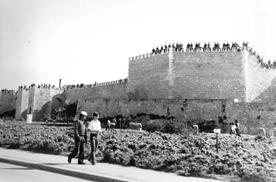

1. & 3. Praça Gil Eanes on April 27, 1974 © José Alexandre Rosa, courtesy of Fototeca Municipal de Lagos
2. People and military in April 1974, courtesy of Fototeca Municipal de Lagos
In spite of the ups and downs and the period of transition experienced after the uprising, 25 April 1974 is a day of freedom and liberation from an old and fascist regime. In truth, the changes were not achieved overnight; instead, they came about through a complex process that resulted in political, social, and cultural change.
So, how did the Portuguese find out about a military operation that was taking place in Lisbon? It was through the Rádio Clube Português and the newspapers. Many people had an understandable fear and agitation about what would happen and whether the operation would succeed. Therefore, the MFA addressed these concerns through a radio broadcast. They transmitted their manifesto, clarifying how they intended to undertake the operation, outlining their goals, and appealing to the population to remain calm. The manifesto included mention of a party which would manage the country’s affairs in the days following 25 April, i.e. the Junta de Salvação Nacional. This new party would embrace three Ds: Democratize, Decolonize and Develop.1
How did the events of 25 April 1974 affect the local political structures of the Algarve? In the words of Colonel José Glória Alves, “[in the Algarve], the 25th April just happened three days later” (“No Algarve, o 25 de Abril só aconteceu três dias depois”)2. In other words, it took this long for the news of the uprising to reach the Algarve.
Today, after 50 years from the date, it’s possible to watch some of the real images from that day thanks to the archive from the Portuguese Television, RTP – Arquivo RTP – vídeos about 25 April 1974 arquivos.rtp.pt/colecoes/25-de-abril-de-1974
2 Luís Pedro Cabral – No Algarve, o 25 de Abril só aconteceu três dias depois. In Contacto, 30 abril 2023. Available at: www.contacto.lu/portugal/muito-depois-do-adeus/1412604.html
 WORDS Marta Nogueira (Arquivo Municipal de Lagos)
WORDS Marta Nogueira (Arquivo Municipal de Lagos)
1 2 3
HISTORY 18 Tomorrow magazine - community magazine for the Algarve | www.tomorrowalgarve.com





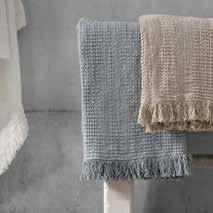








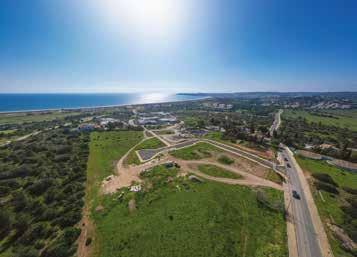
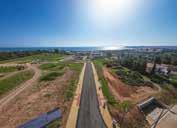
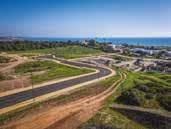
Knowledge and Quality are Key TELEPHONE: +351 282 697 791 LAGOS STORE: Parque Industrial do Infante, Rua da Torre, Loja 1, 8600-256 Odiáxere | info@linen-etc.com LAGOA STORE: EN 125 Parque Empresarial, Lote 3, 8400-431 Lagoa lagoa@linen- etc.com Open Monday to Saturday 10.00 - 18.00 At L ine n - e tc co m y o u c a n e xp e c t t h e p e r fec t c h o ic e o f l in e n f o r b e d r oo m s , b a t h r oo m s a n d h o m e d e c o r, fo r h o m e a n d r e n t a l acco m m o d a t io n Q u a lity b e d line n s i n c oo l an d cr is p co tto n Ev e r y s ize o f s h ee t im a g in a b le S o f t a n d flu f f y q u a lity t owe ls Bedding & towels made in Portugal Q u a lity a n d p r ice g u a r a n tee d . L ine n la b e llin g s e r v ice D e liv e r y s e r v ice C a ll in , o r c a ll u s f o r e v e r y t h in g y o u n ee d to k n ow a b o u t b e dd in g , towe ls a n d h o m e c o m fo r t s Shop in store or on-line Simply the best quality and price Rua José Ventura Neto Cabrita Lote 1 Loja B 8600-774 Lagos, Algarve, Portugal www.batistaproperty.com | Email: info@batistaproperty.com | Tel: 00351 282 043 679 We have a growing database of clients looking to buy, contact us today. Building Plot with Breath-taking Ocean Views Located at Meia Praia 1,350,000 € | Ref.: T167 Alto da Meia Praia is a prestigious development consisting of eight plots. It offers contemporary architecture, stunning sea views, privacy, and close proximity to the city. The plot for sale, number 5, has a total area of 3,846m2. It allows for the construction of a villa with one floor plus a basement, totaling 411m2. Are you selling your property?

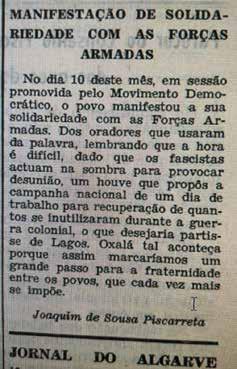
Interestingly, the old political systems, those chosen by the previous political regime, were still in charge until the new Decree Law n.º 236/74 was implemented on 3 June. So how did they manage the situation until new political bodies could be established? This is an interesting question, particularly in terms of the official approach taken by each council. The Livros de Atas de Vereação / de Reuniões de Câmara (the book containing the minutes of the meetings) registered the following:
The councils of Lagos, Vila Real de Santo António, Olhão, Tavira and Loulé all held meetings during the month of April where it was discussed what had happened. The meeting in Lagos was convened especially to evaluate the political climate. It was very well attended by the general public and involved some lively discussion. The records show that there was considerable tension between the Executive Board and some of the public in attendance, such as with the architect José Veloso and the artist Deodato Santos. It is also interesting to note that the President of the Câmara expressed support for the military operation and also sought clarification regarding the political position. However, he agreed to maintain the current political status in order to guarantee general order. The President also made a reference to a public demonstration that had taken place on Saturday, 27 April in Gil Eanes Square that he had not been made aware of and into which he says that he was not invited. The demonstration was very well attended by the public.
Lagos, Vila Real de Santo António, Tavira and Loulé councils all decided to send a telegram to congratulate both the military on their successful operation and the Junta de Salvação Nacional. Olhão council was more cautious. Their executive board accepted and agreed with the programme established by the Junta de Salvação Nacional but chose not to communicate their position in order to avoid clashes.
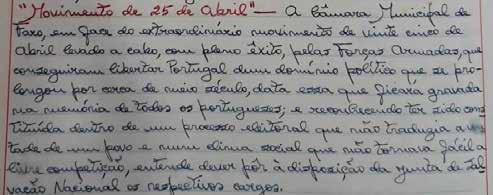
Aljezur, Lagoa and Faro councils all held meetings on 2 May to discuss events and also agreed to send telegrams congratulating the Movimento das Forças Armadas or the Junta de Salvação Nacional. In the meetings of Aljezur and Faro, this was one of the items for discussion along with others regarding general administration. In Lagoa, the meeting was convened especially to evaluate the current political situation, and the meeting minutes reference recent events, but little discussion is noted.
Both Aljezur and Lagoa issued short statements compared to Faro whose statement was longer and warmer: “… the extraordinary movement of 25 April taken by the Forças Armadas freed Portugal from a political regime that lasted almost half a century … and recognise that the câmara was established in an electoral process that did not represent the will of the people … join the Forças Armadas movement unconditionally….”
In its meeting on 2 May, Faro decided to designate street names with significant dates, i.e., 25 April and 1 Maio (to represent the workers). However, these new street designations would not replace the old street names that were linked with the dictatorial regime, as had happened in other councils. The public does not appear to have participated in these three meetings.
In Silves, the subject was discussed at its meeting of 7 May along with other matters relating to general administration. The câmara congratulated the Junta de Salvação Nacional and demonstrated their agreement to cede power to that party, indicating that normal activity would continue until a replacement was in place. It was also agreed a telegram would be sent to the President of the Junta de Salvação Nacional to congratulate him and inform him of the outcome of the meeting. This telegram was also published in two national journals: Diário de Notícias and Diário de Lisboa The information also noted that a number of people had requested that the câmara change the names of some streets to 25 Abril.
Monchique câmara’s meeting of 2 May makes no mention of the military operation. This is curious because, in Foia, mountain communication equipment from Guarda Nacional Republicana, Guarda Fiscal, PIDE and from the Legião Portuguesa was installed at its highest part. This equipment, crucial to communication with the Algarve, was disconnected by the military from the 25 April movement, namely through the involvement of Colonel José Glória Alves.
Again, in Monchique câmara’s meeting of 20 June, it’s noted that the new party from the provisional regime, the Comissão Administrativa da Câmara Municipal de Monchique, would take power, although no reference is made to the military operations of 25 April.
There is a similar position in S. Brás de Alportel, which also made no mention of the movement. The executive board in charge remained until 28 June, when the Comissão Administrativa took charge. During this period, there are no references to the military operation, and the work of the câmara continued as normal. There was a proposal from the Movimento Democrático to change the avenue named after the dictator, António Oliveira Salazar, but this question was delayed (information provided by the Arquivo Municipal de S. Brás de Alportel).
There is an interesting anomaly in Albufeira. The 1974 meetings record book was destroyed at that time. There were many difficulties in the administration of the câmara until the arrival of Colonel Glória Alves (information provided by the Arquivo Municipal de Albufeira), which might explain this.
In the Algarve, the response from the local power structures to the revolution was progressive. Everything was new and anything could happen. Today, after 50 years, we should say thank you to all those who were stronger than their fears and continued with the actions that secured the freedom and rights the Portuguese enjoy today.
The 25th of April was and is a beautiful, bright day. It is a day of freedom when the rights of everyone are respected. “May freedom be with us all.”
Acknowledgments: Lynn Williams (proofreading) and the following archivists who provided us with copies of the minutes of the meetings: Arquivos Municipais de Lagos (Dora Matias); Vila Real de Santo António (Madalena Guerreiro and Alexandra Cordeiro); Olhão (Helena Vinagre and Pedro Bandarra); Tavira (Isabel Salvado); Loulé (Nelson Vaquinhas); Aljezur (Isabel Canais); Lagoa (Diogo Vivas); Faro (Tiago Barão); S. Brás de Alportel (Vera Gonçalves); Albufeira (Sónia Negrão), and to João Gonçalves from the Câmara Municipal de Silves and Marisa Sampaio from the Câmara Municipal de Monchique.
Please go to our website for a list of references. tomorrowalgarve.com/community-news
HISTORY 20 Tomorrow magazine - community magazine for the Algarve | www.tomorrowalgarve.com


































As suas caras de Confiança da ótica em Lagos Quite Simply Your property, Our priority. Web: algarve-retreats.com Email: info@algarve-retreats.com Tel: (00351) 282 183 798 Property Management, rentals and sales

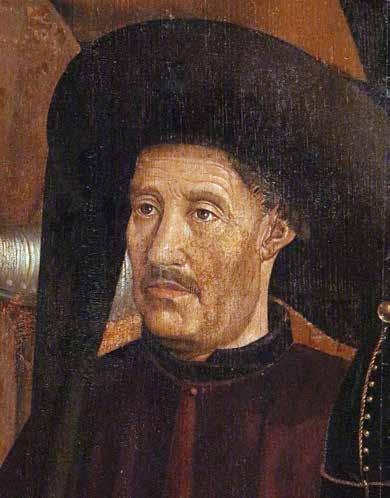
refused to accept the established belief that the navigable oceans ended at Cape Bojador, on the west coast of Africa. Legend had it that no ship could go further. Henry sent a series of captains south from Lagos in missions to prove otherwise and finally, in 1434, Gill Eanes pushed further than any and rounded the notorious cape, and safely returned. (It is now thought that he misidentified the landmark and was in fact about 200 km short!) Henry again enhanced his reputation. His captains had mastered the trade winds, and developed a new vessel –the caravel – which was to play a vital role in Portugal’s prosperity.
Henry’s second set of enterprises focused on discovery along the Atlantic coast of Africa. Here he had mixed success. His captains discovered and took possession of Madeira and the Cape Verde islands, but all attempts to take over the Canary Islands from Castilian control failed. Voyages along the African coast continued throughout the rest of his life, ultimately extending over 2,000 km of coastline beyond Cape Bojador.
The Shapers of Portugal
Infante Dom Henrique
In this series, we investigate the historical figures who have shaped Portugal.
WORDS James Plaskitt
Henry the Navigator 1394–1460 has a heroic status in Portugal’s history. For a long time, the ‘Sage of Sagres’ was seen as the inspiration for Portugal’s age of discovery and the genius who discovered the secrets of navigation and opened the globe for exploration. But the truth is far more complicated, and Henry has a leger comprising a few notable successes offset by a number of profound failures.
Born in 1394, he was the grandson of John of Gaunt, and cousin to England’s Henry V. Of all his father’s (King John I) sons, he was the most spirited and ambitious. He was raised to believe in the need to crusade against Islam and in the necessity to earn his place at court through acts of valour.
The foundation stone of his reputation was the 1415 seizure of Ceuta on the Moroccan coast, opposite Gibraltar. This was one of Islam’s key trading ports, and its seizure in just one day by a vast army led by Henry astonished the Portuguese with its audacity. The triumph seemed to set Henry’s mind on Islamic conquest for the rest of his life. As it turned out, Ceuta was a symbolic victory only. The port lost strength under Portuguese control and many came to think the capture had been a misguided concept in the first place.
Henry cashed in on his Ceuta reputation. The king, whatever his misgivings, ended up backing his son’s further daring initiatives. The first of these was a brilliant success. Henry
At the same time as driving forward his African exploration, Henry continued with his zealous drive to reconquer Islamic territory, notably Morocco. This led to one of his greatest failures – the abortive attempt in 1437 to seize Tangier. The raid was an utter failure. Henry was able to escape from the fiasco only on the basis of a deal with city’s rulers: that he left his younger brother Fernando, who had been his second in command, as hostage, to be released once Ceuta was returned to Moorish control. Henry, however, had no intention of ceding the port – and his reputation – and so his brother languished in Tangier, dying there a few years later.
Henry sought to avenge his Tangier defeat. He hatched schemes to seize Gibraltar but was blocked by the king. He tried to join a mission inspired by the pope in 1456 to seize back control of Constantinople from the Turks, but it came to nothing.
By far the most controversial aspect of Henry’s life is that he started Portugal’s involvement in the African slave trade. All his crusading and exploring had to be paid for. He had money from the Knights of Christ, and from trading monopolies endorsed by the pope, and some gold found on African riverbeds. But in slaves, he saw a source of wealth, thinly concealed under a veneer of bringing heathens to the Christian faith. The first slaves arrived in Lagos in 1444, causing a sensation in the town. Henry supervised the unloading in person and took his own quota of the sorry cargo. Thousands more were to follow before anyone began questioning whether this practice was in any way ethical.
For the deeply ascetic Henry, this visionary mix of exploration, conquest and crusading had unstoppable momentum, whether it was meeting with triumph or disaster. To most of his contemporaries, he showed heroic qualities, underpinned by his legendary efforts to ensure his reputation was cast in the best possible light. From the vantage point of history, he was maybe more a reckless, self-obsessed opportunist: a master puppeteer of adventure, rarely going to sea himself, but issuing orders from his promontory rock at Sagres or his villa in Raposeira, sending others out to take all the risks involved in shaping Portugal’s future in the way his obsessed mind saw it.
Next month: King Manuel I
HISTORY 22 Tomorrow magazine - community magazine for the Algarve | www.tomorrowalgarve.com
Henry the Navigator c.1470 © Nuno Gonçalves, Public domain, via Wikimedia Commons
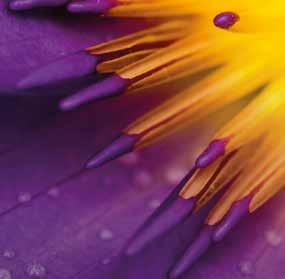



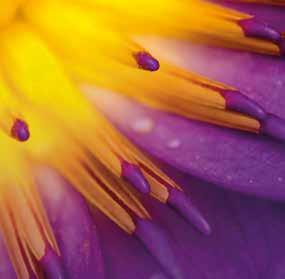













(+351) 931 785 741 info@lawspropertyportugal.com www.lawspropertyportugal.com WE HAVE A LARGE DATA BASE WE PROVIDE A COMPREHENSIVE NATIONAL / INTERNATIONAL MARKETING SERVICE + Photography, Virtual Tour, Drone Images are Included VISIT OUR NEW WEBSITE AMI 19476 LIST YOUR PROPERTY FOR JUST 2.5% + IVA WHY PAY MORE?
Separating the Wheat from the Chaff
From the granary of wheat to the granary of history…
WORDS AND PHOTOGRAPHY Ricardo Soares
Vila do Bispo was known as the Granary of the Algarve as a result of the Wheat Campaign, a national strategy launched in 1929 to combat dependence on cereal imports.
Many families migrated to Vila do Bispo to work the land with cereal farming, mainly coming from neighbouring municipalities and the Alentejo. The evidence of this former industry can still be found in the remains of various threshing floors and mills, such as those on the ridges of Vila do Bispo and the villages of Raposeira, Figueira, Budens and Barão de São Miguel.
At a town hall meeting on 15 June 1955, it was decided to sell 1,600m2 of municipal land, known as Eiras do Município, to the National Federation of Wheat Producers (FNPT, later EPAC) for the construction of two granaries. The buildings on the edge of the town were constructed in the mid-1950s. In the 1970s and 1980s, with the gradual disinvestment in national agricultural activity, Vila do Bispo’s granary, among others, lost importance and fell into a state of abandonment. The space began to fulfil a new community mission, hosting parties, dances, exhibitions, public meetings and political rallies until 1997, when the Town Hall acquired it and transformed it into a municipal warehouse.
In 2016, the process of rehabilitating Vila do Bispo’s old granaries began, a project that came to fruition on 20 January 2024 with the opening to the public of the Vila do Bispo Museum –Celeiro da História (Granary of History).

softness of the valleys, remote movements that persist in time and in the strength of the local people.
A Sorting Machine
On display in the museum is a rotary sieve machine that came from one of the granaries in Vila do Bispo. It was made in 1957 and has registration plate No. 69 from the National Federation of Wheat Producers. The machine was produced in the Italian factory – P. Ballarini e Figli in Sassuolo – and was used to husk, clean, and separate cereal grains by size.
A Toast to History
The Sagres beer brand was created in 1940 by Sociedade Central de Cervejas as a prestige beer for its representation at the Portuguese World Exhibition, held in Lisbon between 23 June and 2 December of that year.
Ricardo Soares is the Archeologist at the Museu de Vila do Bispo.
Despite this era being confined to history, the old customs are still very much present. The countryside is still combed with cereal and the shepherds still drive their cattle through the
Open Tuesday to Sunday, 10 am to 6 pm €5.00 / €2.50 (discount rate)
Sítio das Eiras, 8650-405 Vila do Bispo www.facebook.com/museuviladobispo
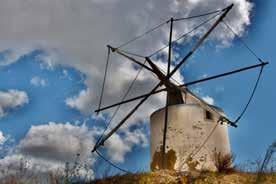
The Vila do Bispo Museum – Celeiro da História was inaugurated on 20 January, 2024, in a ceremony presided over by Mayor Rute Silva, in the presence of the president of CCDR Algarve, José Apolinário.
This museum space includes an expository/interpretive narrative about the municipality’s collective heritage from its geological foundation. The exhibits lead you through the local evidence of dinosaurs to archaeological finds, shipwrecks, fishing and stories from WW2 that explain the history and character of its people.
This recourse is the result of an investment of more than 2.9 million euros, which was financed by the CRESC ALGARVE 2020 Program.

 1. Seara de Trigo, Raposeira 2018
2. Moinho da Torre, Budens 2021
3. Máquina escolhedeira, Museu de Vila do Bispo Soares
1. Seara de Trigo, Raposeira 2018
2. Moinho da Torre, Budens 2021
3. Máquina escolhedeira, Museu de Vila do Bispo Soares
1 3 2 HISTORY 24 Tomorrow magazine - community magazine for the Algarve | www.tomorrowalgarve.com

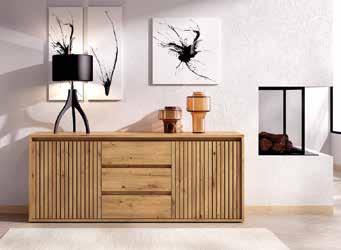









furniture Design • Exterior • Accessories mobiliário (+351) 282 762 070 - info@furnishyourabode.com - www.furnishyourabode.com Rua Professor Dr. Luís de Albuquerque, lt.44 - 8600-615 Lagos - Algarve - Portugal Outdoor Furniture BBQsPortugal Barbecues Outdoor Heating Pizza Ovens Accessories www.barbecueportugal.com (+351) 282 762 070 info@barbecueportugal.com Your ceramic grills of choice
The Arade
Stories Washed up by the River
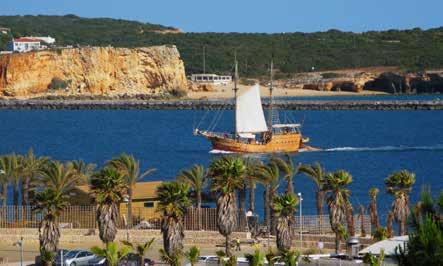
Portimão is probably the most important town in the Algarve. Its location at the mouth of the Arade River is responsible for its enduring significance. It sits on the sheltered west side of the estuary, which makes it an ideal port. A new exhibition at the Portimão Museum is celebrating its unique history.
WORDS Julian Putley

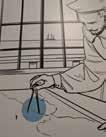

By the 1970s, the river and estuary were becoming silted up, and dredging was necessary to maintain a navigable depth. The dredged material was deposited on the riverbanks, and many items in the dredged material were found to contain artefacts from prehistoric times. Several groups partnered with the museum to develop a research project (DETDA). The Stories Brought by the River is the name of the ongoing exhibit.
The Arade has been navigated for millennia. From the time of the Moors until the 19th century, the Arade was navigable as far north as Silves, about 12 kilometres (7.5 mi), where an important port existed, especially for the cork trade, wine, olive oil and food like dried fruit and nuts. Nowadays, only small boats can go that far.
From the end of the 15th century, Portimão became a shipbuilding and repair centre. Wood from the mountainous region of Monchique was essential for this activity and the Arade provided the means of transport from Silves to Portimão. Archaeological artefacts like caulking material, nails and bolts have all been found in the waters near Portimão, attesting to it as a boat-building hub. Other items have determined that trading and shipping of material on a transoceanic level have been ongoing since Roman times. Lead plumbs, probe plumbs, dividers and compasses have been identified and are on display.
Over the centuries, the mouth of the Arade, with its safe harbour and port town of Portimão, was linked to Andalusia and North Africa via the Gulf of Cadiz. Further afield, links to the Mediterranean countries of France, Italy and even Greece have been recognised as trading destinations. It was safer to voyage by sea than to travel overland. Trade in Roman times, as today, was the basis for a solid economy and allowed for expansion and voyages of discovery.
Besides trade and shipping, artefacts have been unearthed that explain details of the defence of the port, from musket balls to military uniform belt buckles. From the 15th century, Portuguese expansion and trade created considerable wealth which resulted in piratical attacks and robberies. Similarly, artefacts have been identified which give us clues of daily life in riverside areas. Given the nature and potential dangers of navigation in unexplored regions, religion and faith were a significant part of the culture.
The displays in the exhibition are cleverly presented, with a drawing of a scene relevant to the artefacts found. Each artefact is highlighted in the drawing and numbered so it can be identified in the display case of the actual item with the corresponding number (as shown).
A trip up the Arade River north to Silves can be a most rewarding experience. Tour boats leave from Ferragudo and Portimão. An experienced tour operator will explain historical buildings, old sardine canneries (an exhibit is displayed in the museum), defunct water mills and a lot more. The river is tidal, so the trips coincide with the ebb and flow of the tide. The volume of water flowing down to the estuary is much diminished today since a lot of water is diverted to the barragems (reservoirs). The trip allows for a few hours to explore Silves.
Silves has a long and storied past. The area has evidence of Stone Age settlements, and an archaeological museum highlights this fact. The historic castle is a ‘must’ on any visit to this once-capital town.
It was the Romans who were first to understand the value of Silves; the ‘Roman Bridge’ crosses the Arade river near the town centre. But it was during the period of Arabian rule (from the early 700s AD) that Silves achieved its greatest prosperity. It stands on a hill at the centre of rich and prolific farmland, and the river was navigable by ocean-going ships, perfect for trade.
A fun and interesting way to understand the Algarve and its diversity is to visit the Portimão Museum and then to explore the Arade River and its environs. You won’t be disappointed.
www.museudeportimao.pt
A solar catamaran from Portimao: www.algarvesunboat.com
For small groups from Ferragudo. Recommended: ferragudoboattrips.com

HISTORY 26 Tomorrow magazine - community magazine for the Algarve | www.tomorrowalgarve.com
Dredger




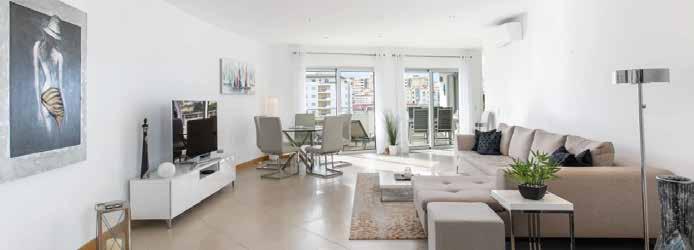


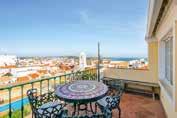
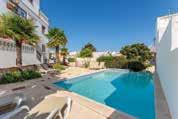
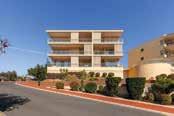










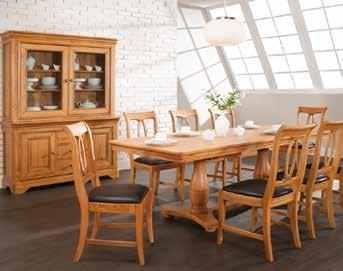

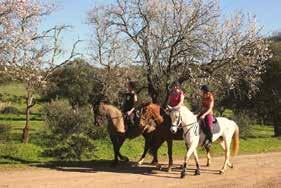
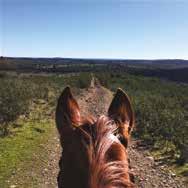
Tables, Chairs, Chests, Wardrobes, Co ee Tables, Bookcases Turn your house into a home www.furnitureworld.pt Urb. da Marateca Lote 5, Chinicato, Lagos 282 798 263 We now sell good quality used furniture too...! Modern top oor apartment 2 2 565 000 € Lagos Ref. CM126 Swedish Real Estate Agency in Algarve +351 282 096 285 | info@casamerame.com | www.casamerame.com AMI 21261 More exclusive apartments in Lagos Private roof terrace - CM129 Unique apartment - CM119 Within Old Town - CM110 Large Balcony - CM109
Charity Update
Progress, Pickleball and a No-Brainer
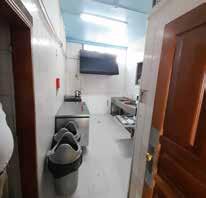

Progress
Firstly, an update on the project for the youth home reported in Tomorrow’s March edition. While not yet completed, the transformation at the children’s home in Lagos, Casa de Acolhimento Nossa Senhora do Carmo, is remarkable. The dour, threadbare space is gone, replaced by freshly painted walls, much-needed electrical works, a completed study space, and a kitchen well underway. A clean, fresh, modern environment is evolving. All I can say is well done!
There’s still much to do, and the need for funds persists. The next priorities are the laundry room and dining room floor, with talk of a volunteer day to tackle both. As always, the Tomorrow community has responded with donations and fun fundraising ideas. A sponsored walk in Aljezur is planned for March, and a pickleball tournament is scheduled for April. Pickleball? If you’ve just grasped the concept of padel, another racket sport has arrived with gusto in Lagos.
Steve and Mary Farmer cinch1947@yahoo.com
BIC/SWIFT: BKBKPTPL
STEPHEN FARMER/CASLAS - CUSTOMER ID: 0896313
ACCOUNT: 181202551434
IBAN: PT50026901810020255143429
WORDS Tom Wilson
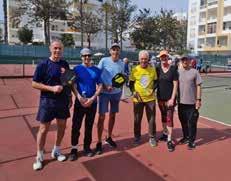
Pickleball
I spoke with Kelly from the Lagos Pickleball Club, who, while giving me a brief history of pickleball, said, “It’s when tennis, ping pong, and badminton have a baby.” Played on a smaller court with a low net, it involves solid paddles hitting a perforated plastic ball over the net. The objective is to score points by landing the ball in the opponent’s court without letting it bounce more than once. Pickleball is accessible to all ages; from what Kelly says, it’s highly addictive!
Kelly discusses the club’s decision to dedicate their first-ever charity event to Casa de Acolhimento Nossa Senhora do Carmo. A tournament is planned for 21 April, starting at 2 pm. A €30 entry per player is paid at the court when you arrive, which covers court fees and food (beer, wine, and soda are for purchase separately). There will be sponsors and vendor booths too! This event is sure to be fun for spectators and players alike. So, if you fancy going along to show support and learn more about pickleball, 21 April is the perfect day.
The club is also hoping to start a project to offer free pickleball lessons and sessions to the children of Casa de Acolhimento Nossa Senhora do Carmo and others in the local area using a pay-it-forward scheme and volunteers.
From Casa de Acolhimento Nossa Senhora do Carmo, thank you to all who have contributed and to all who will in the future.
Lagos Pickleball Club @ The Lagos Tennis Club
Kelly Maciuba
+351 914 419 913
+309 287 3858 (WhatsApp)
www.facebook.com/groups/3501257833422240/

A no-brainer
Finally, I am giving a shout-out to the community for help for those who help us. For anyone living in Portugal, the Bombeiros need no introduction. Yearly, we witness heroics as yet another fire rages across the country. However, the Bombeiros in Portugal (many of whom are volunteers) also provide vital support to the local community through community outreach programs, education, search and rescue, and emergency medical assistance.
It comes as no surprise that they are underfunded – what public service isn’t these days? And so, those whose sole purpose is to help us sometimes need to turn to us for help. Giving money to the Bombeiros, in general, is a no-brainer, and a donation given today could go towards saving you or a loved one in the future.
Messines Bombeiros have a goal in sight: a new multiple-transport ambulance to transport patients undergoing regular hospital treatments, hemodialysis, or physiotherapy. When you spend your hours helping so many in need daily, you need to be in tip-top shape. Ambulances, like any other vehicles, get old and need to be replaced; this is the case in Messines.
Giving to the Bombeiros is like donating to a big community insurance pot. After all, none of us knows when the fickle fingers of fate will find us dialing 112.
Like I said, a no-brainer!
Before After CHARITY 28 Tomorrow magazine - community magazine for the Algarve |
www.tomorrowalgarve.com



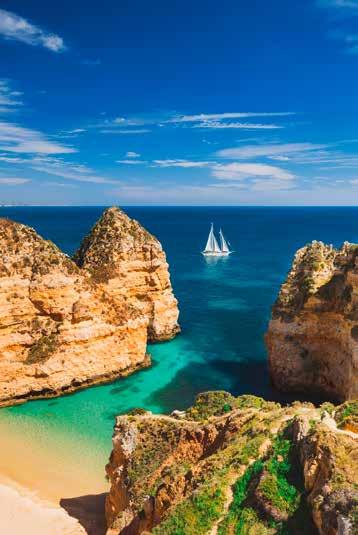






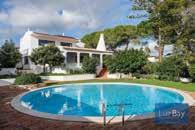



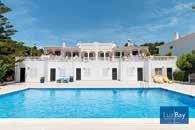




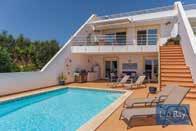




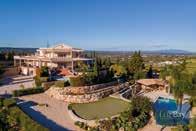



LET US FIND YOUR PROPERTY T (00351) 282 31 31 39 PROPERTY MEDIACAO IMOBILIARIA, LDA SALES RENTALS & Algarvacation.com Lda - AMI 7224 Estrada Nacional 125 - K.M. 56.0 - Porches GPS : 37.126594, -8.402926 Algarvacation.com (00351) 282 313 139 - (00351) 918 402 149 info@algarvacation.com - martina@algarvacation.com SALES - RENTALS - MANAGEMENT V4 in Praia
Luz
sea views €1.600,000 T3 Apartment in central Praia
Luz €525,000 T4 Villa in central Praia da Luz
sea views €975,000
da
with
da
with
T2 Townhouse in Praia da Luz with sea veiws €420,000
Luz Parque LDA - Soc Mediação Imobiliária LDA AMI 11781 Established in 1992, the team at Luz Bay have sold thousand of properties in and around the Praia da Luz and Lagos areas. Our firendly team provides a personal service from start to finish of your buying/sellng process. Pedro +351 919 722 962 pedro@luz-bay.com Kate +351 913 467 021 kate@luz-bay.com www.luz-bay.com For more infromation contact:
V4 Villa between Praia da Luz and Burgau €2.500,000

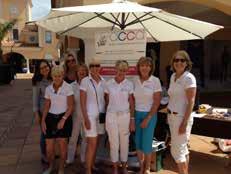


Children in Need


The Associação de Crianças Carenciadas do Algarve (ACCA) is committed to bringing smiles to the faces of young children. As a volunteer or sponsor, your support will put food in little mouths, shoes on small feet, and stability and security in young lives.
WORDS Vaughan Willmore
For nearly 20 years, ACCA has been helping children in the Algarve who are handicapped, orphaned, living in poverty or abandoned. Based in Almancil, ACCA is a registered charity run by committee members who freely give their time and experience. Its president is Wanda Crawford, who arrived here from the USA nearly 25 years ago. “My mother taught me the importance of doing good deeds,” said Wanda. “I’d enjoyed a successful career in the States, but I knew something was missing from my life and arriving here in Portugal gave me the opportunity to help local children. I love being hands-on with the kids and although they’re not my own, I feel in some way that they are. Visiting them in the various institutions we support and the difference they make feels very rewarding.”
The range of initiatives supported by ACCA is impressive. This is facilitated with the help of Akredita in Quarteira, an organisation that helps get young children and early teens off the streets and into a secure environment where therapists help with school work and nurture an interest in learning. ACCA paid for a kitchen, enabling the youngsters to be taught basic cooking skills so they learn about nutrition and how to look after themselves. ACCA has helped with the costs of building dormitories at Casa das Rapazes, a boys’ home in Faro; they’ve also provided funds for the children to have days out with trips to the cinema and local football matches.
Fisio São Brás is a clinic in São Brás del Alportel which helps local children with speech problems
and also those who need help with walking. ACCA gives the opportunity for up to 45 children a year to receive therapy in this centre.
card packs, producing ACCA-branded T-shirts, and donating gifts for fundraising auctions.

Neci-Núcleo de Educação Da Criança Inadaptada (NECI) is a treatment centre for handicapped children and a day centre for handicapped people of all ages. ACCA covered the cost of a ‘snooze room’ at the centre to help agitated, disabled children to rest and relax.
Wanda told me that taking a role in ACCA has proved to be one of the best decisions of her life. “I can never get over what a labour of love this charity is for the entire ACCA team,” she said, “and I am honoured to be a part of the team.” Fundamental to ACCA’s work are their wonderful volunteers. Indeed, volunteering with ACCA doesn’t need to be an ongoing commitment, albeit that obviously helps. Perhaps you could help by manning an ACCA stall at a garden party, selling at Christmas markets, or delivering and collecting donations. You’ll make new friends and help ACCA raise funds to continue its great work. As Wanda said, “We need your time – just a little will do – and your enthusiasm!”
Sponsors also make a real difference and, in return, can be associated with ACCA events –sporting and social – where their branding takes pride of place on display and publicity materials. Opportunities include involvement in projects such as ACCA’s luxury greetings and Christmas
Donations are always welcome and of help. As Wanda rightly pointed out, “Many of us expats have an enviable lifestyle here and can enjoy the facilities and comfort the Algarve has to offer. But while we can take advantage of sporting opportunities and fine dining, the average salary for an office worker here is just €1,000 per month; others, such as gardeners, pool cleaners and restaurant workers, can receive almost half of that, and often only in the high season. Many families’ incomes do not cover basic needs, medication, or specialist support.”
Whether it’s by way of volunteering, sponsorship or donations, your help can make a real difference to the lives of so many young children. As Wanda said, “More than anything, we want to give underprivileged children the chance to be kids, enjoy life, and experience new opportunities to flourish and grow.”
Would a donation of €10 a month change your life? Almost certainly not, but it would make a world of difference to the work of ACCA and the children they help.
More details of the initiatives ACCA has supported are available on their website at https://acca4kids.com email accakid@gmail.com
You can donate by direct debit, cash or cheque to the ACCA bank account: Banco BIC (Vilamoura branch). As a recognised charity, donations can be discounted against IRS Portuguese Tax payments.
If you wish to donate through an international transfer: SWIFT/BIC: BPNPPTPL.
IBAN: PT50 0079 0000 4342 6419 1012 2
CHARITY 30 Tomorrow magazine - community magazine for the Algarve | www.tomorrowalgarve.com
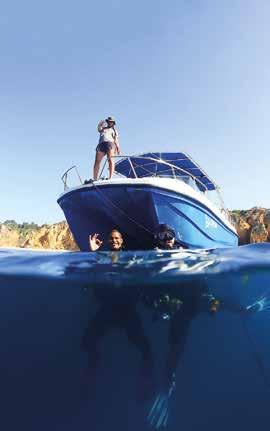
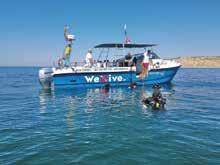








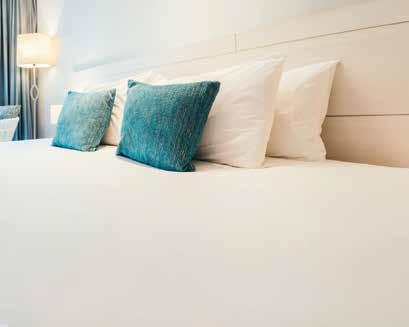

Looking for some underwater adventures? Award winning diving centre in Lagos Marina with a professional team with over 20 years of scuba diving experience. From beginner to instructor level and 5 to 40 meter dives, safety is their priority. w (+351) 916 959 233 (+351) 936 959 234 D wedive.pt r info@wedive.pt Follow: f l @wedive.lagos RNAVT 10992 YOUR NEW HIGH CLASS, LOW COST CAR RENTAL & AIRPORT TRANSFER COMPANY COMPLIMENTARY Water, crisps, biscuits, mixed nuts & sweets | All transfers after 9pm & before 6am are subject to a €10 surcharge +351 911 99 69 39 www.1on1renandtrans.com @1on1renandtrans.com bookings@1on1renandtrans.com 49€ Portimão, Praia da Rocha, Alvor 59€ Monchique, Lagos, Praia da Luz Burgau, Budens, Salema NEW AREA CAR RENTAL DAY & AIRPORT TRANSFERS Contact us for more information FREE DRIVERS REQUIRED - FULL & PART TIME You must live in or near the Portimão area, hold a valid Portuguese driver license, preferrably with 997 accreditation but not esential. Competitive package includes basic salary + commissions As advertised above up to 2 adults As advertised above up to 2 adults +€5 on above rate up to 3 adults +€10 on above rate up to 4 adults +€25 on above rate up to 6 adults Rua Dr. Paulo Jorge L. Godinho Lote 7 – Loja D 8600-774 Lagos (+351) 282 769 115 (+351) 933 746 442 info@cjdecor.com www.cjdecor.com INTERIOR DESIGN CONFECTION UPHOLSTERY FURNITURE We are experts in turning property management into a stress-free and profitable experience Imagine the peace of mind that comes with knowing your property is in the hands of dedicated professionals. Contact us today. Email: geral@rentalgest.com Phone: +351 963 591 311 Website: www.rentalgest.com Special Offer We welcome new clients with reduced commissions for the first semester.
Poetry Press
If you would like to submit a poem, please send to the editor at sophie@tomorrowalgarve.com
The Fiesta of Spring Flowers
by Lorraine DeSousa
Harbinger of Spring, dusts the ground with pepper and salt
As Grand Master Crocus taps his baton, to bring a halt, To the symphony’s chatter, so he can get underway And show off Bluestar’s talent, beckoning him to play.
The Foamflower opens with the start of the timpani. Whilst the Purple Violas start to strum Spring’s symphony. Golden Trumpet Daffodils, raise their heads toward the sun,
Whilst the Harmony Iris waits for the sign it has begun.
The Coral bells form clouds, waiting for the ring.
Scarlet Bugler listens for the hummingbirds to sing. Double Rock Rose only wants to jive, The Wolfsbane howls that it is once again alive.
Grape Hyacinth takes a sip of a honeyed wine, Tulips place a kiss upon the honeysuckle vine.
Throwing colours and scents into a huge melting pot, The Fiesta of spring flowers says never, Forget-me-not.
ldesousa.oas@gmail.com
This poem was written in response to #the365poetrypromptchallenge on Facebook.
Prompt/If I Were A Poem
Love Hidden In The Margins
by M J Mallon
If I were a poem
I’d grace a beautiful notebook Its cover bright sunflowers
Inside a ray of sunshine. Beautiful calligraphy to highlight Tiny ink splodges to add character Tear drops to remind me of sad days Poems of sunshine and sadness
Grief and joy. Life and loves. Funny poems. nonsense poems. All manner of poems.
Torn pages, folded memories, Crisp, pristine fragments
Forgotten dreams
Edges filled with notes Synonyms and rhyme schemes.
If I were a poem
I’d close my eyes, meditate, Light a candle, And write one just for you.
On the last page you’ll find it. Hidden in the margins, In our secret language Saying how much I love you.
MJ loves to write magical and poetic stories, sprinkling them with a liberal dollop of extraordinarily imaginative magic!
MJ’s writing credits include Bloodstone –The Curse of Time and the second in the series, Golden Healer – The Curse of Time. She writes YA fantasy/paranormal novels, horror/ghost short stories, and multigenre flash fiction, as well as micro poetry – haiku and Tanka. Her poetry/ flash collections include Lockdown Innit, Mr. Sagittarius Poetry & Prose, The Hedge Witch And The Musical Poet, and Do What You Love! Her eclectic blog shares her love of reading, reviewing, writing, poetry, photography and travel.
linktr.ee/mjmallonauthor
 2001, Brunei
2001, Brunei
HEARTACHE
by Nick Darker
The young and fit give not a thought
To health: it’s free, abundant, like the air Not factored into life’s great plans Assumed forever to be there.
For me I loved my hectic sports I played my games of squash with dash; Though knees and back could slow me down I never dreamed my heart would crash.
It happened in the Niah Caves
Where hanging bats and swiftlets nest I’d raced up tiers of slippery steps Then felt sharp pains within my chest.
This took place half a dozen times
When simple movements caused dull pain –The doctor sought a specialist; “Angina” was their set refrain.
All other worries fade away
When one reflects that all could end: Promotion, jobs – they all are dust
The only question: will it mend?
And so in haste to Singapore
To see Professor Arthur Tan. Distinguished Asians wait their turn; Heart specialist guru, he’s the man!
The angiogram is set for 3
But first my body’s shaved quite bare: I feel like Samson, neutered, weak, A chicken stripped for Easter fare!
The theatre’s modern, stuffed with gear; The nurse assures that all is fine: I’m on the table, draped in sheets, TV screens lock their eyes on mine.
The X-ray story tells it clear
A coronary tube is squashed and bent He first ballooned it into shape Then propped it open with a ‘stent’.
The micro-navigation’s great; To do all this INSIDE the heart!
Those fiddly bits of platinum Are gently placed to play their part.
At once the pressure-pain is gone, Its shadow lifted from my brow; My heart is flush with blood again My dreams can dwell on futures now.
ARTS AND CULTURE 32 Tomorrow magazine - community magazine for the Algarve | www.tomorrowalgarve.com






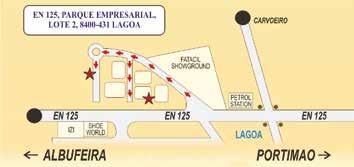



Benefit Concert
The Rotary Club of Lagos is hosting a concert to raise money for CASLAS children’s home in Lagos. Music students from Cannes in France are travelling to the Algarve to perform classical music to audiences in Lagos and Portimão.
Tickets at bol.pt: Adults €15 / Children €10
22 April, 9 pm – Lagos Cultural Centre
24 April, 9 pm – TEMPO Theatre, Portimão
+351 966 174 907 or +351 960 031 799
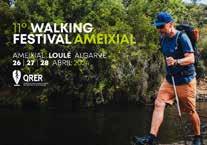
Walking Festival – Loulé
Visitors can take part in dozens of walks, revealing this territory's natural and cultural richness. Walks vary from 1.5 to 4 hours. During each walk, hikers can see installations from local artists, and throughout the three-day festival, there are events such as yoga workshops, sports massages, music and dances.
The event fee is €10 / €8.50. Children (age 12 and under) are free of charge with a paying adult but they need to register.
wfameixial.qrer.pt/en
The Freedom Run
To celebrate the day that Portugal won freedom, Portimão council is hosting the Corrida da Liberdade Portimão (Portimão Freedom Race), starting and finishing in the Portimão’s riverfront area. This event is for all ages. Running or walking, the most important thing is to participate! There is a 5 km, 10 km and a children’s race.
Registrations until 24 March €8,00
Or from 25 March to 24 April €10,00
25 April, 10 am
Portimão
www.corridadaliberdadeportimao.pt

Reinterpretar o Mar
Reinterpreting the Sea is a travelling exhibition of the project Fish Prints by artist Daniela da Silva Ferreira (Luzalba). It focuses on the art of printing fish, and shows and records the region's biodiversity.
Monday to Friday until 19 April, 10 am – 4.30 pm
Vila do Bispo Interpretation Centre, a temporary exhibition space at the Vila do Bispo Museum –Celeiro da História.
info@luzalba.one linktr.ee/luzalba
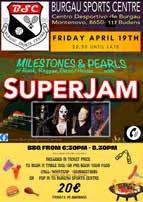
Live Music
This BBQ and live music event features the reggae tribute band Superjam. Playing rock, reggae, disco, and house music, this promises to be a ‘rocking’ event.
Friday, 10 April
BBQ from 6:30 – 8:30
Music: 8.30 pm until late
Burgau Sports Centre
Book tickets in advance (€20) +351 926 371 695
Movies and Musicals
The Cantus Nortada choir (The Swedish Choir) sing classical favourites from your favourite musicals to raise money for charity. Tickets cost 10€.
4 May, 5 pm
Centro Cristão Fonte dea Vida, Lagos/ Sargaçal
Fienta.com/Cantus Nortarda Movies&Musicals
Vernice Contemporanea
In partnership with Salema Eco Camp, Archeometra, Mediapresseswiss and Inews, Vernice Contemporanea is holding its first international open-air contemporary art festival in the Salema Nature Park. The festival’s theme is the natural elements: fire, earth, water and air, elements which characterise Portugal’s south coast.
Registration via Eco Camp Reception or vernicecontemporanea@gmail.com.
Friday, 19 April, 5 pm – 10 pm
Saturday, 20 April from 10 am – 8 pm
Sunday, 21 April from 10 am – 8 pm
Salema Eco Camp
www.vernicecontemporanea.com
What's on For more events and activities check our online calendar: www.tomorrowalgarve.com/calendar Disclaimer: While we believe this information to be correct at the time of printing, local events can be subject to change, so we always advise checking the links given before you arrive at the event.
WHAT'S ON 34 Tomorrow magazine - community magazine for the Algarve | www.tomorrowalgarve.com
Useful Numbers
COUNTRY CODE: +351
INFO:
EMERGENCY
HOSPITAL
SNS 24 (OPTION 9 FOR ENGLISH)
RED CROSS
FIRE SERVICE
POLICE SERVICE (PSP)
NATIONAL GUARD (GNR)
TELECOM NAT. INFO
CITY COUNCIL
TOURIST OFFICE
TOWN INFO
TOURIST SUPPORT TAXI SERVICE
BUS STATION
TRAIN STATION
CULTURAL CENTRE
HEALTH CENTRE
LUZ DOC (LUZ)
PRIVATE HOSPITAL LOCKSMITH (LUÍS)
SAFE COMMUNITIES PORTUGAL WWW.FACEBOOK.COM/SCALGARVE
PHARMACIES/CHEMIST
LACOBRIGENSE
NEVES CHEMIST
RIBEIRO LOPES
TELLO CHEMIST
SILVA CHEMIST
ODIÁXERE CHEMIST
CONSULATES/EMBASSIES
BRITISH FRANCE (FARO)
GERMAN (LAGOS)
NETHERLANDS (FARO)
CANADA (FARO)
SWEDISH (FARO)
IRISH TOMORROW
SALES


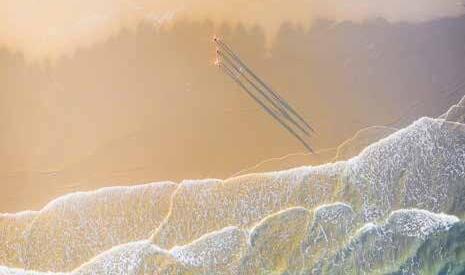
USEFUL NUMBERS
MAGAZINE & AD DESIGN Let us assist you in finding your new home Free Valuations Contact Us Today! oando.pt/westalgarve | westalgarve@oando.pt | Luz +351 282 768 703 Q U I N TA D O L A GO L A GOS P RA I A D A L U Z A L J EZ UR PO R T O
EDITORIAL
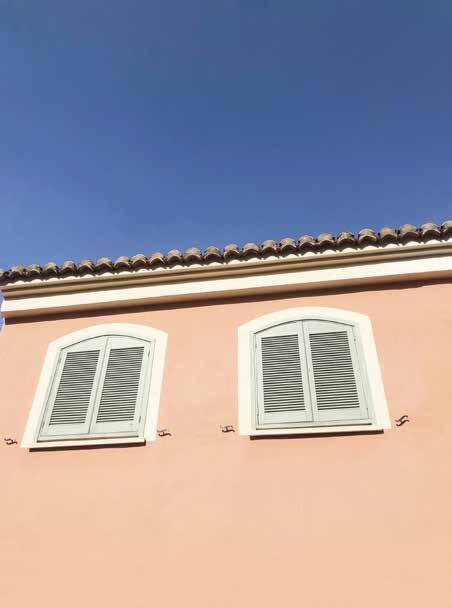
Blushing
WORDS Flora Kouta
Don’t even think about lumping the colour blush with the pink of Barbie dolls and bubblegum. Blush is not cloying or sickly sweet. It’s a soft and subtle hue grounded in the colours of sunbaked earth. Blush is a comforting colour with peachy undertones that warm the atmosphere of any interior. Think of blush as the insides of seashells, the colour of the sky when the last rays of the sun have sunk beneath the cliffs. Blush is the warm clay in a potter’s hands; it’s an elegant glass of Douro rosé … don’t you love it already?
Pink interiors are soft and reassuring and give us an overall sense that everything will be okay. They alleviate feelings of anger, aggression, resentment and neglect. Many studies have examined how exposure to the colour pink has calming effects on our nervous system. In 1979, research scientist Alexander Schauss managed to convince a correctional institution in the US that inmates who were placed in cells painted pink became less aggressive.
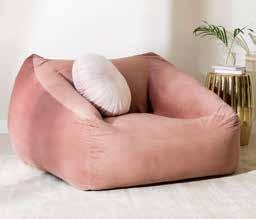
He called his shade of pink ‘Baker-Miller’ after the prison’s directors. As word got around about the calming effects of pink décor, psychiatric units and other holding areas were painted Baker-Miller Pink. Today, model Kendall Jenner is one of the colour’s biggest fans. Explaining why she painted her living room pink, she said, “Baker-Miller Pink is the only colour scientifically proven to calm you AND suppress your appetite. I was like, I NEED this colour in my house!”
In 2011, Swiss psychologist Daniela Späth wrote about her own experiments with a more gentle shade of pink paint. She called hers “Cool Down Pink”, and she applied it to cell walls in ten prisons across Switzerland. Over the course of her four-year study, prison guards consistently reported less aggressive behaviour in prisoners who were placed in the pink cells.
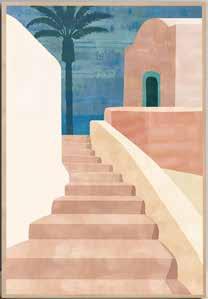

I personally think that Baker-Miller and Cool Down are both too bright to be calming. Being surrounded by these pinks would make me feel the sort of sick I feel when I’ve eaten a whole bag of jelly babies. Späth probably understood the effects of colour better than Strauss, but it seems neither of them had ever met the colour blush. If they had used blush, prisoners worldwide would be so chilled out that they’d be doing yoga and cross-stitching.
Anyway, thank god we are not confined to a cell and can enjoy decorating with blush in every room of our homes. Combine blush with earthy tones like terracotta and rust to create a serene, spa-like space. And If you think blush might look a little child-like think again, it can be awfully sophisticated when paired with dove grey or deep indigo.


1
3 2 4 5 6 HOMES & GARDENS 36 Tomorrow magazine - community magazine for the Algarve | www.tomorrowalgarve.com
Pink






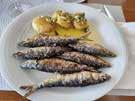
























GRILL SPECIALS EVERYDAY Open Tuesday to Sunday 12pm-3pm & 6.30pm-10pm Bookings recomended: 282 761 539 Rua da Praia, 8600-112 Praia da Luz REOPENED UNDER NEW MANAGEMENT Nestled along the sun-kissed shores, our beach bar offers a coastal experience with refreshing cocktails, delicious bites infused with local flavors, and breathtaking ocean views. Reservations: +351 282 014 738 Praia das Cabanas Velhas, Burgau Winter schedule 12:30h to 18:30h. Closed Wednesdays Restaurante As Cabanas @restauranteascabanas The Mosto experience. Exceptional wines & tapas. Taste, shop and make memories. mostowine.shop 3 to 11:30pm • Closed SundayS Rua dos Celeiros, Ed. Adega • Lt 4 • lj 7 • Lagos • (+351) 282 769 527 • hello@mostowine.shop
Though we’ve been conditioned from birth to think of pink as a girly colour, back in the 1920s, pink was used for boys and blue for girls. It wasn’t until the mid-20th century that advertising agencies began pushing pink as an exclusively feminine colour.
My daughters Amarisse and Sienna used to love pink. When I say ‘love’, I mean they tolerated me dressing them up as little pink sweeties. They were my dolls with pink hibiscus flowers in their hair, pink ruffle skirts and candy pink metallic sandals. Each time I look at pictures of them aged three and four, I ache for those days. It was so lovely to be the boss of everything. Now it’s all fake eyelashes, black tracksuits and scathing remarks. The only pink I’ve seen in years is the infected belly piercings! Their bedrooms have gone from the prettiest pink to the dirtiest dishwater. Each morning, in the calm after the storm of them hauling themselves from their holes, I wander lonely as a cloud tutting to myself about how depressing their rooms are.
But last week, Sienna decided to indulge me by suggesting I might like to add a touch of blush to her grey room. I am not stupid; she wants a new phone and I saw the glint in her eye. But I didn’t care. The thought of being allowed to play with her room got me so excited. Yes, I promise to make it blush, not girly pink. Yes, it will only be a little bit, and there will be no ruffles or frills.


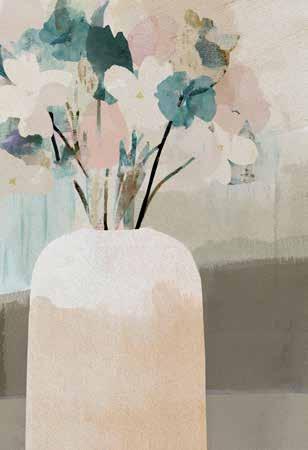
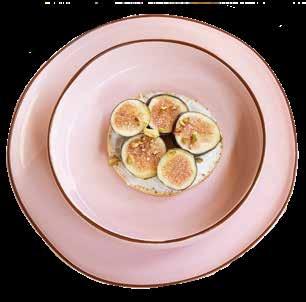
I got on my sewing machine in a frenzy and made some blush linen curtains and ran to Portimão for a blush duvet and cushions (pictured). I was a bit scared she’d call the whole thing off when she saw how lovely it looked, so I added some grey geometric cushions to tone down the pretty. The grey walls looked a bit stark, towering above the blush, so I bought a white feather dream-catcher from one of the tourist shops in Lagos and hung it above the bed.

Ah the relief, when she nodded in mild amusement. Her room looked fabulous for a full two days. Now the bed can’t be seen underneath the heaps of clothes, the dream-catcher has lost its feathers and the curtains are stained with makeup. But the beautiful blush is still there and will live to fight another day!

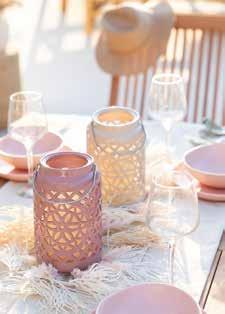
1. BLUSH HOUSE WITH SHUTTERS taken by Flora in Silves
2. BLUSH STEPS WALL ART www.florakouta.com
3. BLUSH BEANBAG ARMCHAIR bit.ly/49GFfkF
4. BLUSH HANDWASH DISPENSER bit.ly/3T9d2f6
5. BLUSH MACRAME bit.ly/3wJmiPP
6. BLUSH BEDLINEN bit.ly/3T8aRIF
7. BLUSH STILL LIFE WALL ART www.florakouta.com
8. BLUSH & BROWN CASES bit.ly/3Ta0rs6
9. BLUSH PLATES WITH FIGS bit.ly/3IxSNCR
10. BLUSH CURTAINS bit.ly/48JgP8D
11. BLUSH BED AGAINST GREY WALL Flora’s daughter’s bedroom
12. BLUSH ABSTRACT ART www.florakouta.com
7 8 9 10 11 12 13 HOMES & GARDENS 38 Tomorrow magazine - community magazine for the Algarve | www.tomorrowalgarve.com
13. BLUSH LANTERN ON TABLE bit.ly/3Pb8mnV
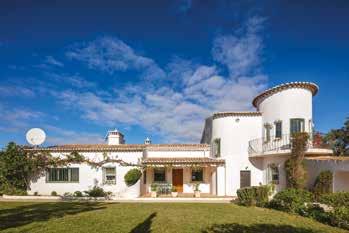

Praia da Luz
4
2


▪
▪
▪
▪
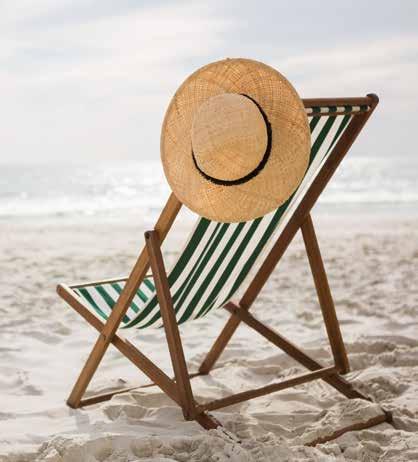
With offices in the UK and Portugal we offer fee based advice on:
Tax efficient investments
Pensions
Non Habiutual Residency
Tax Planning matthew@arthurbrowns.com +351 910 262 378 +44 (0) 781 110 9523 Portugal office established 2016
Pensions, tax and wealth management advice for expats in Portugal, Europe and the UK. www.arthurbrowns.com (+351) 282 789 336 nick.sadler@sadlersproperty.com www.sadlersproperty.com Funchal, Lagos
Regulated in the UK and Portugal FCA reg no. 825843
bedroom 303 sq m villa with 10,000 sqm of land Price: €995,000 AMI 14220 | Algarve representatives for Knight Frank LLP since 2005
bedroom 110 sqm apartment for
in Coraluz Price: €439,000
sale

SPORTS ROUND UP
 WORDS David Lugg
WORDS David Lugg








































RISING STAR







Algarve Football



The Algarve’s two representatives in the men’s Portuguese Primeira Liga have continued their poor form throughout March. Farense (Faro) and Portimonense (Portimão) have not tasted victory since January, meaning both sides have slipped down the table towards the relegation zone. The two sides play each other in the last game of the season, but, by then, they hope to have picked up enough points to avoid dropping back down into the second division.

Algarve Rugby
CRUAl rugby club will host two youth games against international opposition at Browns Sports Resort near Vilamoura. On 23 March, they will play an under-14s match against Langley from Vancouver, Canada, whilst on 5 April, there is an under-15s fixture against Garryowen Rugby from Limerick, Ireland. Children and parents across the Algarve are invited to attend the games to sample a taste of rugby culture. Training sessions are held on Tuesday and Thursday in Lagoa, and on Monday and Wednesday in Faro. crualg@gmail.com
International Rugby

Miriam Martins
Guia Feminino continues to set the pace at the top of the table in the Women’s Regional Division 3. After last season’s relegation, they remain undefeated as they look to advance to the playoffs, which would see them bounce back to National Division 2 South at the first attempt.
Basketball
Twenty twenty-four has been a tough year for the two Algarve sides in the men’s Liga Portugal de basketball. Immortal (Albufeira) and Portimonense (Portimão) have struggled to pick up points and sit precariously close to the relegation zone. They both face several crunch games over the next few weeks as they aim to preserve their top-flight status.
The top women’s side Immortal Tcars (Albufeira) sits comfortably in mid-table as they look to press on and make the end-ofseason play-offs. Their campaign has been strong to this point, and they have all but guaranteed another season in the top division of women’s basketball.
The Portuguese women’s national side have won their first ever match in the 2024 Rugby Europe Championship. Following last season’s historic promotion, Portugal are playing in the second tier of European rugby. Despite losing their opening match 31-7 against the Netherlands, a 27-0 home victory over Sweden saw them create a little piece of history in their first victory at this level. They conclude their championship with a tough away match against current champions Spain on 30 March.
The Portugal men’s team lost in the final of the Rugby Europe Championship in Paris. Following a thrilling 33-30 victory over Spain in the semi-final, Portugal advanced to face Georgia, who they met in the group stages in the recent World Cup. On that occasion, Portugal outplayed their opponents and came away with an 18-18 draw. However, this time, they were no match for the powerful Georgian side and never looked like pulling off a victory. A series of Portuguese errors meant that Georgia went in at halftime 12-3 to the good, having kicked four penalties to one. The second half was one-way traffic, with Georgia scoring four tries before a late consolation from replacement winger Rodrigo Marta. The final score was Georgia 36-10 Portugal.
Miriam Martins is one of Portugal’s hottest young prospects in handball. The eighteen-year-old plays for the Gil Eanes (Secondary School) in Lagos which features in the National 1st Division. Miriam has also represented her country at international-level for both the under-17 and under-18 sides. In February, the Lagos municipality honoured Miriam with an award for best breakthrough athlete. The Gil Eanes club also won the best team and best coach awards. With the season ending in May, Gil Eanes are comfortably in mid-table and look a safe bet for another season in the top flight.
Surfing
Algarve surfer Yolanda Hopkins has qualified for the 2024 Olympic Games in Paris by reaching the semi-finals of the World Surfing Games. The Faro-born athlete finished fifth in Tokyo in 2020 and will look to be amongst the medals this time round. Following qualification, Hopkins exclaimed, “It’s incredible. It seemed like such a distant dream and today it happened. I don’t even have words.” Despite the Olympics being held in France, the twenty-five-year-old will travel to the French island of Tahiti for her event.
If you wish to publicise a sporting event or a ‘rising star’ contact our sports editor David Lugg: david@tomorrowalgarve.com
SPORTS & LEISURE 40 Tomorrow magazine - community magazine for the Algarve | www.tomorrowalgarve.com

Cannabis –From ‘Highs’ to Health Care
Portugal, particularly the Algarve, is one of the main producers of top-quality medicinal cannabis in the world due to its excellent conditions for growing, processing, and exporting the drug.

Did you know?
Portugal’s current cannabis laws are regarded as among the most progressive in the world. In 2001, the government decriminalised personal cannabis use, focusing on treatment rather than punishment. As such, the overall number of drug users in the country has gone down. However, it wasn’t until 2018 that medicinal cannabis was legalised.
WORDS
Things have moved a long way since the recreational use of cannabis or marijuana during the 1960s counterculture in the Western world when getting “high” was very popular among bohemians. Just within the last decade, the focus has strongly shifted to perfecting cannabis for medical treatments.
By November last year, the Portuguese Ministry of Agriculture had issued licences to 42 companies to operate in activities related to medicinal cannabis. More companies are believed to be seeking licences to become involved in medicinal cannabis production under Portugal’s strict legal and security rules.
Doctors say high-quality medicinal cannabis can alleviate symptoms such as the pain associated with cancer and multiple sclerosis, and the nausea and vomiting caused by chemotherapy. It can also reduce body temperatures, stimulate appetite, prevent weight loss in people with HIV/AIDS, help treat certain rare forms of epilepsy, and even improve anxiety, insomnia and sleep quality.

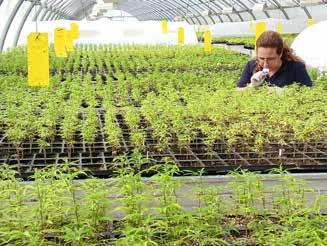
Both creams and oils can relieve pain.
Pharmacists can advise which are best for different kinds of pain.
Creams are generally weaker and €15 to €20 less expensive than oils or pills.
Historians say cannabis has been used for healing purposes for almost 5,000 years, starting in 2,800 BC, when it was lauded in writings by Emperor Shen Nung, who is known as “the father of Chinese medicine”. Ancient Indian Hindus, Assyrians, Greeks and Romans all praised the therapeutic qualities of cannabis, which they claimed were able to help with a great array of problems, including arthritis, asthma and amenorrhea.
With medicinal cannabis use in Portugal now perfectly legal, local pharmacists say it is available in various forms without a doctor’s prescription. Oils, creams and pills can be bought at prices around €16 to €50 to alleviate pain or skin problems. Prescriptions may be needed for stronger and much more expensive cannabis medications.
To meet the increasing demand, the first medicinal cannabis company to be established in the Algarve with 100% Portuguese capital has been growing, processing and packaging on its farm in Castro Marim and factory in Vila Real de Santo António in the eastern Algarve since 2021. The latest fully licensed farm has been set up by a Danish company on wellprotected land not far from the centre of Lagoa. Sandra Sal, the Portugal-based agronomist with the Danish Scholl medical company, has explained to us that in addition to the sunny weather, “the sandy soil on their farm is just what is needed because it allows good water drainage and a breathable environment for the roots of the plants cultivated organically".
She says, however, that there are concerns about the shortage of water availability due to droughts, even though cannabis is not as water-demanding as many other plants. She adds that the Lagoa farm “has a water-saving policy with which water is collected from their drainage system, guided into a pond, and then used mainly for drip irrigation”. The Danish company is investing in the improvement of the irrigation system to be able to manage it and control it carefully to guarantee there’s no water wastage. All being well, the aim is to begin exporting to several European countries in the middle of this year.
Len Port
HEALTH & BEAUTY 42 Tomorrow magazine - community magazine for the Algarve | www.tomorrowalgarve.com
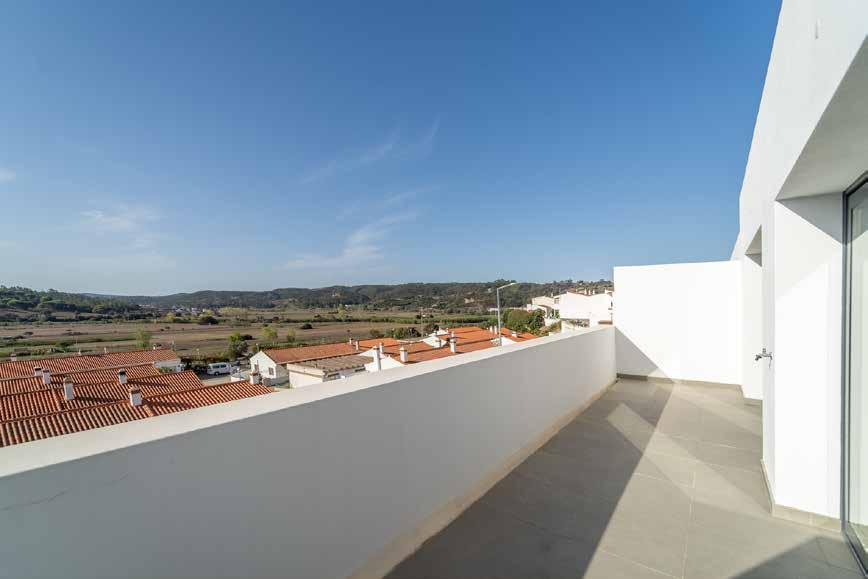

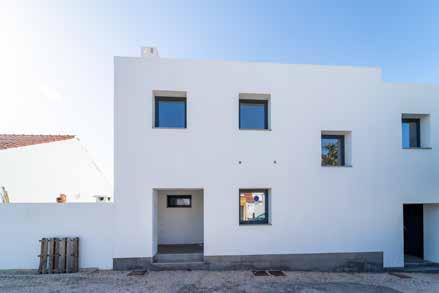
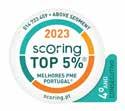

Golf Warm-Up
WORDS Ann de Jongh

The images of the pink azaleas at Augusta, the first major of the year, signal the beginning of the golf season. We are lucky in the Algarve to be able to play all year round, but whether we play every week or have had a break for a few months, it is still important to warm up every time we go to play.
Doing a proper warm-up before hitting our first tee shot allows us to prepare our body (and mind) for the game ahead. Generally, the first hole is one which requires a driver, the club we swing the fastest, so it makes sense that our body is ready for this. When we hit our driver, the muscles work in the same way as those of a 60-metre sprinter. We would never sprint without first warming up as we know that something is likely to go “ping” if we do, yet we are happy to exert a massive amount of force onto our spine and the rest of our body without preparing it. A warm-up will help to prevent injury, enable us to swing freer and move better.
A warm-up does not need to take a long time – five minutes is better than nothing. It needs to be a way of mobilising. You do not want to hold stretches for a long time, and you do not want to grab three clubs and swing them together! It is about creating movement and mobility within the joints and activating the muscles.
There are three main areas we need to cover:
• Loosening the posterior chain (spine and hamstrings)
• Mobilising the hips
• Creating rotation in the thoracic spine
Here are three exercises I always do before playing:
1 - Bows and side lean Take the club and raise it above your head. Lean to one side and then the other, then place the club across your chest or top of your back. Hinge at your waist as you bow, and then come back to standing.
2 - Hip Circles Raise Lift one leg, knee bent and circle in one direction. Repeat in the opposite direction. Keep the club on the ground for stability.
3 - Stalk Drill Take a split stance with the left foot forward. Place your club across your chest or shoulders and rotate into the backswing.
Finish with a few jumps to create some explosiveness, which will enable you to smash that first tee shot!
Ann de Jongh is a health & wellbeing coach



Facial Peels
WORDS Donna Groom

Skin peels, also known as chemical peels, are cosmetic procedures designed to improve the texture and appearance of the skin by removing its outermost layer. There are various types of skin peels, each offering distinct benefits and catering to different skin concerns.
Glycolic Acid Peels: Derived from sugar cane, glycolic acid is a popular choice for superficial peels. It exfoliates the skin while addressing issues like fine lines, mild sun damage, and uneven pigmentation. This peel is often recommended for individuals seeking a refreshed and brighter complexion.
Salicylic Acid Peels: Ideal for those with oily or acne-prone skin, salicylic acid peels penetrate deep into the pores to unclog and remove excess oil. They can be effective in reducing acne, blackheads, and promoting overall skin clarity.
Lactic Acid Peels: Derived from milk, lactic acid peels are known for their hydrating properties. They are suitable for sensitive skin and help improve moisture retention, making them a choice for addressing issues like dryness and dullness.
TCA (Trichloroacetic Acid) Peels: TCA peels are versatile and can be customised for different skin depths. Superficial chemical peels exfoliate only the top layer of skin, while medium and deep chemical peels exfoliate into the upper and mid dermis. They are effective in treating fine lines, wrinkles, and pigmentation irregularities. The recovery time varies depending on the peel’s strength.
Jessner’s Peel: This peel combines salicylic acid, lactic acid, and resorcinol. It is often used to treat more severe skin concerns, such as deep wrinkles, acne scars, and sun damage. Jessner’s peels typically require some downtime for recovery.
Mandelic acid peels: These peels have gained in popularity for their effectiveness and suitability for various skin types, particularly those with sensitive skin. Derived from bitter almonds, mandelic acid is an alpha hydroxy acid (AHA) known for its larger molecular structure compared to other AHAs, making it gentler on the skin. This type of peel has anti-ageing properties and helps with hyperpigmentation.
Before opting for a specific skin peel, it is crucial to consult with a skincare professional to determine the most suitable option based on individual skin type, concerns and desired outcomes. Additionally, post-peel skincare and sun protection are essential for maximising results and minimising potential side effects.
Donna is a beauty therapist and medical micro pigmentation specialist. She works at the Kutting Room in Praia da Luz.
facebook.com/fit2lovelife instagram.com/anndejongh
donna.medicalbeauty@gmail.com HEALTH & BEAUTY 44 Tomorrow magazine - community magazine for the Algarve | www.tomorrowalgarve.com

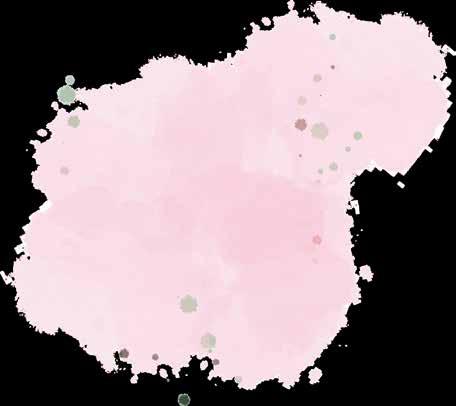































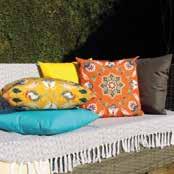














+351 918 350 053 Intermarché - Lagos Piso 0 - Ground Floor Mon to Sat 9h - 18h • Skin Treatments • V w +351 966 791 196 ] 37.106444,-8.675194 Outdoor cushions & throws new in store! See our main advert on page 19 South Asian cuisine Restaurant & Takeaway Rua António José de Almeida 14A, 8600-733 Lagos 920 432 369 282 082 225 MOMO EXPRESS for British Tax Payers Bookkeeping and Payroll services for UK businesses, including VAT returns and CIS returns. ICB certified practice UK Tel: 020 81 508 508 PT Tel: 911 081 886 mary@mk-bookkeeping.co.uk www.mk-bookkeeping.co.uk +351 936 387 512 info@stevendunwell.com Any computer or device Network & Email problems Software & Hardware issues I.T. Support Services for Homes & Business www.stevendunwell.com Now Openin Alcantarilha LAGOS I - LAGOS II - PORTIMÃO - ALMANCIL - ALCANTARILHA - OLHÃO OPEN EVERY DAY 10AM-20PM VISIT OUR NEW MASSAGE SPACE ALSO IN OLHÃO IMPROVE YOUR QUALITY OF LIFE WITH HYPNOTHERAPY WWW.BIT.LY/HYPNOCALL WWW.FORTUNALIVING.ORG I am Andrea and I invite you to embark on a journey to unlock the incredible potential within you through the power of hypnotherapy. Why Choose Hypnotherapy? *Stress Relief *Pain Management *Boost Confidence *Better Sleep *Overcome Fears and Phobias *Break Habits *Goal Achievement BOOK YOUR DISCOVERY CALL
Quay Lagos
As she celebrates ten years at Quay Lagos, Tomorrow spoke to Susie Robson about her 45 years in the hospitality industry.
For those who have enjoyed the waterfront bar and restaurant located in the beautiful Marina de Lagos, Susie will be a familiar and welcoming face. The restauranter has worked in the hospitality trade all her working life. After college, she trained as a chef and then bought The Smoking Dog, a pub in Malmesbury, Wiltshire, “I just love the job,” she explains.
Known for its antisocial hours, the restaurant industry suited her and husband, David, who worked in finance. He worked away from home Monday through Friday, allowing her to dedicate her time to the business.
The couple were keen sailors in their spare time and sailed their boat across the Atlantic in 2009. They kept their yacht in Plymouth, so it was a dream come true when she took over a bistro in the marina. “This was the beginning of my love of cooking by the sea. Then, when it became busier, I moved to front of house.”
Susie had begun looking for other premises by the sea when she was contacted by a friend who had a sailing boat in Lagos marina and saw that the premises had become available. It seemed like an ideal opportunity for her and David to start a new chapter in a different country.

Susie believes that a marina setting is great for business despite high rents. “People love something to look at – we have the sun all day and great sunsets – you can people watch.”
However, it wasn’t all plain sailing! Moving to Portugal and setting up a business in an unfamiliar country was a challenge. Fortunately, David helped her with the accounting side of the business, but, initially, the seasonality of the Algarve restaurant trade was challenging. “My husband is into his stats, so we have records for ten years and we think, how did we survive back then? But we now have more year-round trade. Mid-November and December are the slowest times and then from January onwards, it gets busier.”
Quay Lagos has also evolved with the help of Jessica, who has been working for Susie since just after she opened. It was serendipity, and they later discovered that their mothers lived in the same village in the UK. “I have taught her all I know – good and bad,” laughs Susie. Now that she is looking towards retirement, Susie is confident that with Jessica at the helm, along with her hardworking, experienced team, the business will continue to thrive in the future while she takes more of a back seat.

Algarve Retreats
Former police officer Adrian Fox has set his sights on making his company Algarve Retreats a bigger player in the Lagos property scene.

The business model has changed from a predominantly British flavour, with a shift to the American taste, and the number of Spanish, French and Italian diners has increased. “We are pigeonholed as being British, but our menu is now very diverse. Our chef is from Venezuela, so some Central American flavours are going into the menu now. Our dishes are all freshly made and we have something for everyone's taste.”
In March, they closed to refurbish the kitchen. The couple likes to keep reinvesting in making the inside appealing. “We want to refresh the front of the house and put in new furniture as it starts to get tired, and we get tired of looking at it.”
Although they sold their boat, Susie and David still enjoy social sailing with friends.Fortunately, running a marina-side business allows them a great lifestyle and the ever-present comings and goings of the sailing community.
+351 282 761 128
www.quaylagos.pt
Adrian has been visiting Lagos for 28 years. While he was working as a police inspector in Sheffield, he and his wife Tracy, a bank manager, bought a villa in Lagos.
Wanting to “live the dream” in the Algarve, they acquired the company Algarve Retreats and decided to put their customer service and people skills into a management and rental business. They have since built a successful company based on their 20 years experience of holidaying, living, and renting in the Algarve.
Adrian and Tracy developed a professional and friendly approach based on great service and trust. Sadly, Tracy passed away and, subsequently, Adrian has thrown himself into taking the business to where she would have wanted it to go.
Algarve Retreats expanded into sales five years ago and this year employed Georgia Barfield as sales manager. With her twenty years of experience, Adrian is confident Georgia will bring a positive change for the business, and he is already seeing an upturn in sales. The company now has seven
staff members, including Adrian, but are recruiting further this year. Their business benefits from positive reviews and word of mouth. They only rent properties that they manage so they can guarantee first-class service, which includes a 24-hour helpline. “There is a definite upturn in the longer winter-let market,” notes Adrian.
The biggest change that Adrian has noticed is the expansion of the North American market which they are targeting with social media campaigns. “The Canadian market has expanded disproportionately against other markets,” notes Adrian, who has come up with a clever way of tapping into this client source. Through his former career, he has a relationship with the International Retired Police Association and uses this connection to source clients in Canada from the Royal Canadian Mounted Police.
Adrian says there is more to come in the future when he announces a “game-changer,” so watch out for Algarve Retreats and maybe some Canadian Mounties in Lagos!
www.algarve-retreats.com
46 Tomorrow magazine - community magazine for the Algarve | www.tomorrowalgarve.com BUSINESS NEWS
Susie with Jess


We are a dedicated financial services provider specialising in moving money overseas utilising great foreign exchange rates From a substantial one-off property sale to regular ongoing payments, you can rely on us to work quickly, reliably and securely. Take charge of your financial freedom by exploring your tailored currency options with us today T +44 (0) 203 974 4738 | +351 282 768 136 E portugal@gcpartners co | W www gcpartners co L Visit our office in Vilamoura Global Currency Exchange Network Limited T/A GC Partners is author sed by the Financial Conduct Author ty under the Payment Serv ces Regulations 2017 FRN 504346 Global Custod al Services Limited T/A GC Partners is authorised and regu ated by the FCA and holds Part IV Permissions under the FSMA 2000 Registration number 595875 Currency made simple
Henderson, Head
Middle East Andrew Fundell, CCO
Grant
of
The Star of Algarve Cuisine
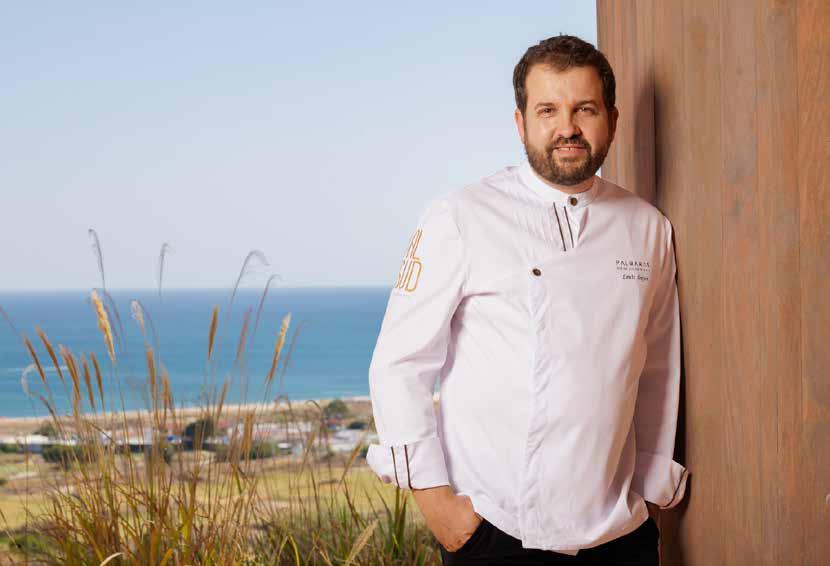
The MICHELIN Star Revelation – Portugal Gala took place on 27 February at the NAU Salgados Congress Palace in Albufeira. This event was the first MICHELIN ceremony dedicated exclusively to Portugal, catapulting Portugal onto the big stages of international cuisine and recognising its potential as a gastronomic destination. Tomorrow spoke to Algarve-based MICHELIN star chef Louis Anjos to mark this historic evolution in Portuguese gastronomy.
For a former Portuguese Chef of the Year, it might be surprising that a career in the kitchen was not an obvious choice for the young Louis Anjos. After finishing Year 9 of schooling and not knowing what area to pursue, his father spotted his talent and suggested a cooking course. At 15 years old, he was one of the youngest students to go to the EHF. It was a period of growth in the restaurant and hotel industry in Portugal, and Louis’s achievement, and that of other colleagues who followed the same path, helped to make the hospitality school Escola de Hotelaria de Fátima, (EHF) famous.
For around 10 years, Louis worked in regional restaurants in the Leiria area until, one day, he saw the Chef of the Year competition in INTER Magazine, and he started to dream big. He wanted to win that competition, a desire that was to change his life. “To do that, I would have to get out of my comfort zone. At that point, I started setting goals and wanting to do something that would make a difference in my career.”
Louis sent his CV from the north to the south of the country to many different restaurants, but in the end, the Algarve called! He worked at Vila Vita, Vila Lara, and then Suites Alba, where he gained more experience. It was time to participate in the competition. Two years after reading that life-changing magazine article, Louis won Chef of the Year
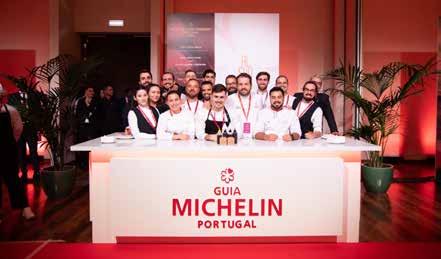
on his first attempt in 2012. “The truth is that I worked hard towards this goal. It was a bit of a solo journey but one that filled me with pride. The first goal was achieved.”
The accolade led to an invitation to head the Bon Bon restaurant in Carvoeiro, which already had a MICHELIN star, but Louis and his team maintained the star for three years. After that, Louis was invited to head the Palmares project. The golf resort was looking to open a gastronomic restaurant and it seemed to Louis like the perfect stage to reach another goal.
In less than six months, he achieved his own MICHELIN star. “When I started working in a kitchen in 1999, having a MICHELIN star was impossible to achieve in my humble vision. However, over the last few years, I have been setting new goals which are always achievable. The path was difficult but full of passion,” he tells me.
The chef is keen not to take all the credit himself, being aware that the key to success is building an excellent team to work behind him. “I always talk about the team because it is the most important thing. The best part is that we do it in a joyful and pressure-free way.”
WORDS Sophie Sadler
FOOD & DRINK 48 Tomorrow magazine - community magazine for the Algarve | www.tomorrowalgarve.com
© MICHELIN Guide


Rua Silva Lopes 14 . 8600-623 Lagos N +351 282 799 445 F I
from 12:20 to 22:30 Closed on Sunday Portuguese contemporary cuisine 12:30 to 15:00 | 18:00 to 22:30 • Closed on Sundays Rua 25 de Abril, N.º 54 • Lagos + 351 282 037 406
Open
l
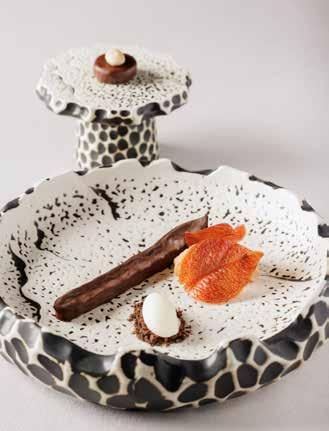
Although not originally from the Algarve – Louis was born in Alcanena – he has come to champion the region’s natural bounty. He confesses to having a ‘fascination’ with products, the Algarve and its surroundings. “I feel lucky to work in the Algarve: I have the best fish and seafood in the world, always fresh and within close proximity.
The Alvor River is less than 500 metres from us. We use lots of bivalves: oysters, clams, cockles or razor clams. I really believe in our excellent product in our traditions, and I really value gastronomic expression; it’s our culture. At Al Sud Palmares, we always try to create a memorable experience that elevates Portuguese gastronomy.”
Louis represents the Algarve for the Art of Tasting, a high-end tourist experience developed in collaboration with MICHELIN and promoted by the Portugal Tourist Board and a CNN Portugal television show. Each episode of the series is dedicated to a different Portuguese region, with eight of Portugal’s most renowned chefs as ambassadors. “There is a moment when your direction as a cook tells you which path you are going to follow: mine was Portuguese/Algarvian cuisine.”
Recently, Louis hosted a visit from the MICHELIN Guide to Lagos. He took them to Ostra Select in Vale de Lama (the oyster farm was featured in Tomorrow’s February edition), and he cooked lobster and oysters for the visitors at Restaurant Camilo. This can only be a huge positive for the western Algarve, putting it firmly on the food map. Louis confirms, “These are very positive partnerships where the main actors are the products. I often say a product has only one rule: don’t spoil it. In this case, the cooking points are the main thing, the flavour is there and simplicity is sometimes the best recipe.”
I asked him how he thought Portuguese food had evolved and if he believed it was now world-class. “Our food is, without a doubt, very special and


has a unique matrix that makes us different from the rest of the world. We have learned to make it elegant, full of flavour and balanced in terms of cooking and acidity.”
So does the Algarve´s most famous chef believe that gaining its own MICHELIN guide will be beneficial to Portugal? “I think it will be a big step towards the gastronomic development of our country. A way to show the world who we are and what we do. I think that in another four or five years and there will be twice as many MICHELIN stars as there are now.”
For a man who got to where he is today by dreaming big, I wonder if he still has the sort of burning ambition that won him a national competition and a MICHELIN star. “My ambition remains the same: to always do more and better, so that the client recognises this evolution. Your smile and joy are my vitamins to continue wanting to do better. I’m a happy man in the kitchen.”
The Algarve is also happy to have such a passionate advocate for its delicious flavours. The stars are aligning for Chef Louis and the Algarve’s gastronomy.
palmaresliving.com/al-sud-restaurant/ theartoftastingportugal.com/
After years of sharing MICHELIN fame with Spain, with one guide for the entire Iberian Peninsula, Portugal could finally shine a light on its chefs’ starry achievements with its first-ever dedicated MICHELIN guide and gala.
The 2024 selection of the MICHELIN Guide brought many new accolades, with a total of 172 restaurants included – eight with two MICHELIN Stars, 31 with one MICHELIN Star. Five venues were recognised with the MICHELIN Green Star and 32 with Bib Gourmand, as well as 96 recommended restaurants.
During the evening, the new Stars were presented and received with great emotion. Ó Balcão, in Santarém, by Chef Rodrigo Castelo, was one of the great surprises of the Gala, winning its first MICHELIN Star, along with the MICHELIN Green Star, thus joining the ranks of the highest excellence in Portugal.
The event represented a big win for the tourism board, along with all the chefs and restaurateurs who saw their efforts rewarded. But the biggest winners are the tourists and everyone who appreciates Algarve cuisine.
guide.michelin.com/en/pt/restaurants
FOOD & DRINK 50 Tomorrow magazine - community magazine for the Algarve | www.tomorrowalgarve.com
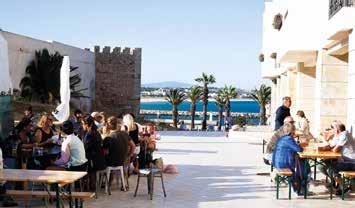























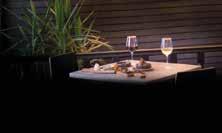
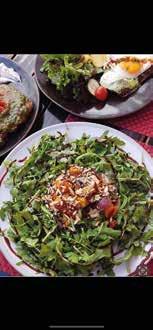

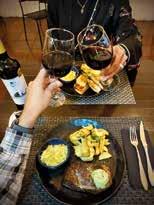
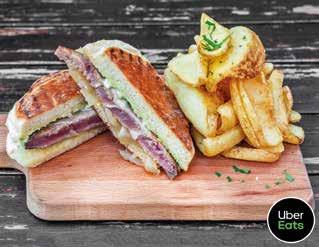


In residence at The Collab Bao Buns | Wontons Shake Shake Fries SUNDAY SESSIONS LIVE MUSIC Every Sunday from 4pm QUIZ NIGHTS
Thursday at 7:30pm English speaking, open to all Large selection of craft beer Natural Portuguese Wine Tasty Cocktails Non-Alcoholic Drinks OLD FACTORY EASTER MARKET April 14th from 11am Live music, fun, fashion & food Opening Times: Monday, Tuesday, Wednesday, Thursday 12-11pm Friday & Saturday 12pm - Midnight | Sunday 12pm - 10pm Loja A (Bloco 1), Antiga Fabrica da Ribeira, Av. d. Descobrimentos, 8600-584, Lagos (Opposite Praia da Batata) +351 937 359 261 www.thecollabportugal.com +351 913 505038 www.casadoprego.com Rua Lançarote de Freitas, 18, 1 Andar 8600-605 Lagos Local food by contemporary people Open every day for lunch & dinner Rooftop terrace bar
Every
Turmeric Fried Squid THAT ASIAN HOME COOK
I love everything about squid. From a good grilled version to crispy fried or aromatic stir fry, it is one of the most delicious proteins to me. It feels like you get the freshest lulas here in the Algarve, so I have this super easy stir fry which incorporates turmeric that I have been wanting to share. It is healthy, fun, and only takes minutes to prepare. So here goes. I hope you try this recipe and enjoy it!
INGREDIENTS
• 4 medium-sized squid
• 1 tsp turmeric powder
• ¼ tsp salt
• ½ tsp light soy
• 1 large red onion sliced
• 4 cloves garlic minced
• 1 tbsp vegetable oil
DIRECTIONS
Firstly, prepare your squid with a good clean. I always get the fishmonger to clean the fish for me. First, remove the tentacles and slice them approximately three tentacles apart. Next, slice the body of your squid into roughly 1 cm pieces. Set aside in a bowl and marinate with turmeric powder and salt. If you like, you can prepare the squid ahead of time and leave it cling-wrapped in the fridge to use later in the day.
Now, heat your wok or pan with vegetable oil. Once it is smoking hot, add your slices of red onions. Stir for a few minutes until translucent, and then add your minced garlic.
As soon as they start to brown, turn your heat up to high and throw in your marinated squid. Your wok should be very hot. I would stir fry the squid for a maximum of 2–3 minutes or until “opaque”. Now add a splash of soy sauce. Stir for another two minutes and watch your squid caramelise.
You are done. Quickly dish out and serve immediately with fragrant steamed rice. If you like, you can top it with coriander and scallions.
Turmeric trivia
Turmeric, or cúcuma in Portuguese, is a super nutritious power food. It has a golden orange colour and is used to add colour but also flavour to food. Yes, it is from the ginger family as you might have guessed.
Used for hundreds of years in Ayurveda healing remedies, Chinese traditional medicine and Asian cooking, it has antiinflammatory properties and is a great source of antioxidants, offering other benefits for the heart and overall health too.

Did you know?
Research now points to squid being a high source of low-fat protein, heart-healthy Vitamin E and omega fatty acids as well as antioxidants to fight off free radicals. It is also proven to contain choline, which encourages brain health!


Joy Entry is a Malaysian home cook based in Lagos who is obsessed with the provocative, unapologetic flavours of South-East Asian cuisine
Instagram: @thatasianhomecook joyentry@gmail.com
FOOD & DRINK 52 Tomorrow magazine - community magazine for the Algarve | www.tomorrowalgarve.com
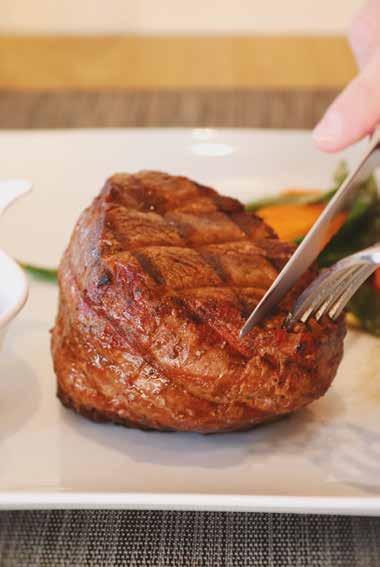

Argentinean meat, wet aged, grass fed and freshly cut on the moment of your order Open Monday to Saturday 18h to 23h Closed Sundays R. Lançarote de Freitas 12, 8600-605 Lagos www.dontoro.com BEST STEAKS IN TOWN ! Reservations: +351 915 757 570
Kinglets: Goldcrests & Firecrests
WORDS Luis Teves Costa

If you read Tomorrow’s February edition, you might have noticed that it featured an article about the great bustard – an enormous flying bird found in the Alentejo plains. This month, we look to the opposite side of the size spectrum and focus on the smallest birds found in Portugal: the goldcrest (Regulus regulus) and the firecrest (Regulus ignicapilla).
The two species are closely related and of very similar size, weight, appearance and behaviour. The Latin names translate to “king/ruler“ or “little king” and “fire-capped king” respectively. Despite their bold names, these are very small animals. In fact, they are the smallest birds found in Europe.
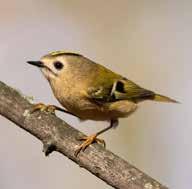
These tiny birds weigh around 6 grams, roughly the weight of a 20-cent coin. Inconspicuous animals, they often join up with flocks of other small birds, perhaps to seek safety in large numbers.
This is a strategy used across the natural world. Being this small means that they are positioned very low on the food chain and are a possible meal for numerous predators such as hawks, snakes or squirrels. As such, these birds keep very active, flitting between trees, bushes and shrubs where they feed on moth eggs, spiders and small insects. The crests, present in both genders, will flare up during courtship or when
excited and this is when their bright crown colours are more striking.
In Portugal, both species are more frequently spotted in northern regions but have been found throughout the whole country in coniferous forests, woods, parks and gardens.
The size and habits of these creatures make sightings very challenging for wildlife enthusiasts and photographers. Spotting these fantastic little feathery friends requires a sharp eye and a certain luck.
Goldcrest vs Firecrest
More plump BODY More slender
Pale green, light grey COLOUR Darker, olive green
Black “pinhead”
EYES Black eyestripe & white brow
Yellow CREST Yellow/orange
6 grams WEIGHT 5–8 grams 14 cm
WINGSPAN 14 cm
2 years LIFESPAN 2 Years
More abundant FREQUENCY Rarer
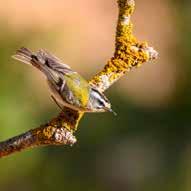
Worldwide, the record for the smallest bird goes to the bee-hummingbird (Mellisuga helenae), native to Cuba. This minuscule passerine weighs as much as a paper clip, around 2 grams, and it’s often mistaken for a flying insect.
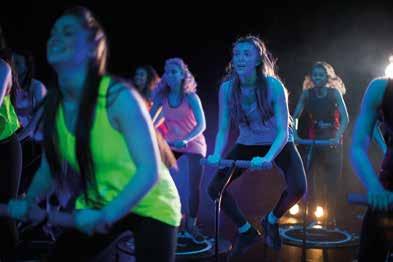

Fun fact
PETS & WILDLIFE 54 Tomorrow magazine - community magazine for the Algarve | www.tomorrowalgarve.com

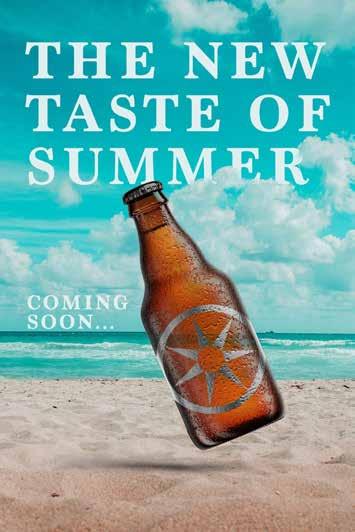

















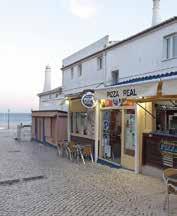









Open 7 days a week 11.30am - 11.30pm Fridays 5pm - 11.30pm (+351) Best pizza in Praia da Luz PRIVATE & COMERCIAL COMPUTER SUPPORT In association with 91 8411 488 ai@ultr8.com House Calls Ultra IT Repair & Upgrades Networks & Cloud Device Fusion AI Integration Graphic Design Crypto Guidance NAS Multi Assistance Services Photography & Videography Virtual 3D Property Tours, Models & Printing Video Surveillance Security www.ultr8.com
Rivers, Valleys and Vineyards
Following Route 222
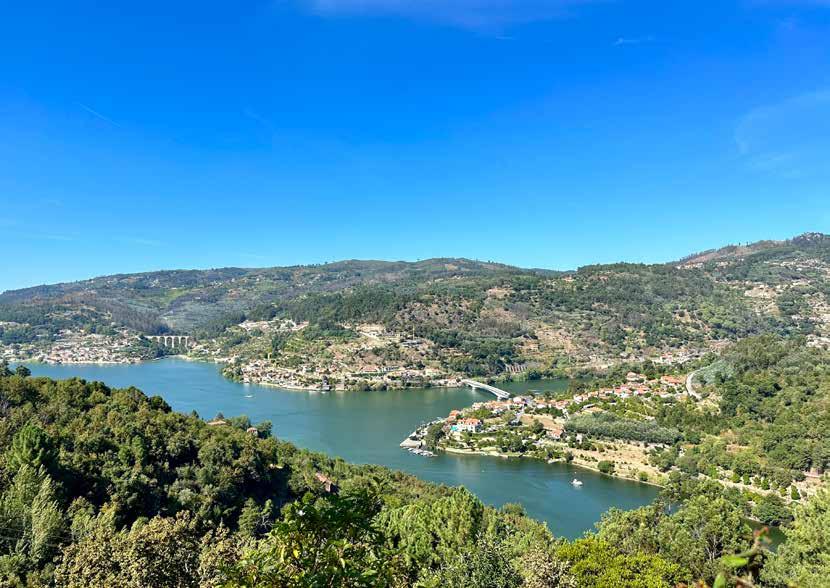
Portugal offers many treasures prone to accolades, whether magnificent buildings, traditional stone villages or majestic views. But, when I heard about a stretch of road in the north of the country, considered the ‘most beautiful in the world’, I pricked up my ears. It had to be tested!
WORDS Lena Strang
We are talking about National Road 222, which follows the Douro River for 226.3 km from Vila Nova de Gaia, on the outskirts of Porto, to Almendra near the Spanish border. Even before setting out on my journey, I learned it crosses three UNESCO World Heritage sites: the Porto riverside area, the wine region of Alto Douro, and the rock engravings at Vale do Côa.
From Mafamude in the centre of Gaia, we set off on our quest in our trusted campervan. Navigating the traffic, we eventually found the zero km point near the island of Santo Ovídio, but from there, it was plain sailing. We drove through the town of Avintes. If you are thinking of lunch at this stage, stop to buy the famous broa de Avintes, a farmhouse bread with a long tradition in the north of the country. Having left the urban landscape behind, we soon encountered winding roads through hamlets, forested hillsides and distant mountain views.
Crossing the River Inha that joins the Douro, we had our first glimpse of the mighty river. Here, you find the first viewpoint along the route,
Miradouro da Lomba, with its extensive views. Miradouro acquires a fitting double meaning here as mirar means ‘to observe’. There are many opportunities to mirar the Douro along the way, making the journey unique.
We continued to pass through charming villages that no doubt harboured immense cultural wealth. Throughout history, lands were successively occupied by different peoples, including the Romans and the Arabs, who all left their mark.
We reached Castelo da Paiva, renowned for producing vinho verde (green wine). An extensive wine, gastronomy and artisan fair is held in the town in July. However, sampling the delicacies will have to wait until next time for us. Instead, we made our way to the Praia Fluvial de Bitetos. Enjoying lunch and watching boats and cruise ships chugging by was thoroughly relaxing.
Cinfães, our next stop, deserves a visit for its history and cultural heritage. It’s linked to the Knights Templars who owned fortresses here,
such as Torre da Chã and numerous interesting Romanesque churches. The town is also connected to Afonso Henriques, the first King of Portugal.
While it is difficult to visit all the miradouros (viewpoints), it is worth making a detour to Miradouro de Teixeirô, regarded as one of the most impressive viewpoints. Overlooking the Douro River at the mouth of the Bestanca River, it offers a unique view over the Old Port, once an important stopping point for the traditional wooden rabelo boats on their way to the Vila Nova de Gaia docks. You can also see the impressive arched railway bridge, Ponte de Pala, on the other side of the river, where the river reaches its highest flow. The scenery is picture postcard perfect.
We snaked our way along the river to reach Resende, which also has its claim to fame – apart from a rich architectural heritage, it boasts delicious cherries. Here, the terraces of the Douro are decorated with cherry groves and countless trails of the Romanesque Route.
Peso da Régua is synonymous with port wine. It’s the oldest demarcated wine region in the world, created in 1756 by the Marques de Pombal. It’s on the undulating slopes of the Alto Douro Wine Valley, where the famous port wine is produced. The sheer beauty of the wavy patterns of the terraces, sometimes perched at seemingly impossible angles, almost takes your breath
Cinfães TRAVEL & OUTDOORS 56 Tomorrow magazine - community magazine for the Algarve | www.tomorrowalgarve.com



▪







▪









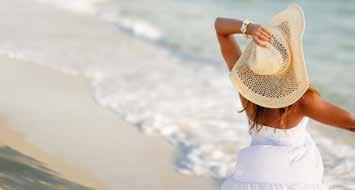
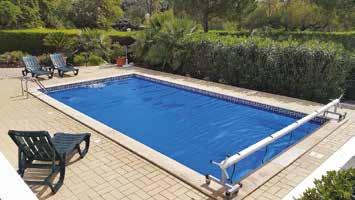






by Sandra Rio events Espaço Multiusos hall l f | gemmaevents.pt sandrario@gemmaevents.pt + 351 282799309 + 351 914822441 Rua Cidade de Torres Vedras, Loja 17 8600-744 Lagos Figura Estável - Mediação Imobiliária, Lda | AMI 12206 SUN 4 Av. dos Descobrimentos, nº 21 São Gonçalo de Lagos - 8600-645 +351 924 469 115 nuno.freire@remax.pt www.remax.pt/nuno_freire NUNO FREIRE
Property Management (non-rental)
Translation and Interpreting
P.A. for the Day
Liaison and Support with Private and Government Entities
a local's expertise, knowledge and contacts Life in the Algarve can be simple
916 294 074 info@algarveconcept.com www.algarveconcept.com
Urb. Quinta de Santo António Rua Conde de Lippe, Lote C25, Cave Q 8600, Lagos (Close to Bella Italia) +351 916 922 021 fb.me/rdhairstudio CUT • WASH AND BLOW DRY KERATINE STRAIGHTENING • COLOURING BEAUTY TREATMENTS Help when you are at a crossroad or need support Certied & Accredited Therapist with 25 years experience Therapy for individuals, couples and groups www.ClaireLinley.com 937 596 679 - Lagos Claire Linley Therapy
▪
▪
Offering
(00351)
away. I can see why it was designated a UNESCO World Heritage Site. From here, the barrels of wine were transported for centuries in the rabelo boats to Vila Nova de Gaia, where the wine was aged in cellars. I’m beginning to understand the significance of the start of Route 222 at Gaia.
It is also the perfect destination for anyone wanting to learn about the history of Douro wines. You could visit the Douro Museum and Quinta do Vallado, which has a fantastic wine cellar. There is another viewpoint, São Leonardo de Galafura, nearby. If a cruise along the river Douro takes your fancy, this is an excellent place to embark.
We had an overnight stopover in a designated space for campervans under the arches of two enormous bridges by the river. What better way to spend the night?
If you are curious about history, a 15-minute detour on the A23 to Lamego will be worth it. The city was central to the nation’s history from its Roman origins to the Christian Reconquest. It was here in 1139 that Afonso Henriques was declared Portugal’s first king and monuments of national reference can be visited.
The gem of Route 222 is undoubtedly the road between Peso da Régua and Pinhão. The 27-km stretch with 93 bends that follow the meandering river presents jaw-dropping vistas at each curve.
Avis has crowned this part of the EN222 as “the road that offers the best driving experience in the world for its location and the spectacular views it offers.” The campervan navigated the snaking, zigzagging road with great aplomb.
Five dams with enormous locks allow navigation along the Douro. We were fortunate to see one of the locks at the Régua dam in operation. A large cruise ship was approaching along the river. There was just enough room for the ship to manoeuvre the dam, which is 85 m long and just 12 m wide. With three mooring floats on both sides of the walls, the ship was lowered 27 m –quite a sight.
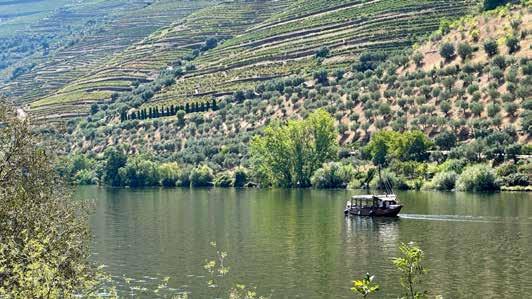
Located at the confluence of the Douro and Pinhão rivers lies the very pretty town of Pinhão. The surrounding terraces and the meticulously aligned vineyards create a unique pattern – a work of intricate art displayed right before you. We strolled along the riverfront, watching the cruise boats and the curved, flat-bottomed rabelo boats that sailed past regularly. They no longer transport barrels of port wine but tourists.
The arrival of the train in 1880 helped transport goods and people. The train station is a work of art in itself. The walls are covered with 24 panels of glazed tiles (azulejos) in shades of blue that depict the Douro landscape and enchanting scenes of the wine harvest.
With more time, we could have embarked on a short train journey as I would have liked to experience the views of the river valley from different angles – a must for next time.
For me, the rest of the route to Almendra was equally spectacular but in a different way. We diverted from the river and drove through more arid regions, although still replete with vineyards, passing through the town of São João da Pesquiera, the oldest recognised municipality in Portugal, created in 1055.
If one hasn’t had a fill of miradouros yet, a detour on the NE222-3 takes you to one of the most famous viewpoints of São Salvador do Mundo,
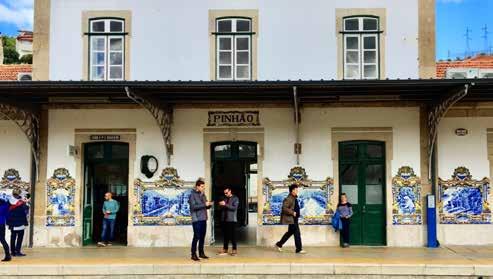
where the sanctuary stands out with its small chapels. You can glimpse the Valeira Dam and, in the background, the Douro railway.
Continuing the detour, you can visit the small schist village of São Xisto overlooking the Douro. It is well preserved and now dedicated to rural tourism.
On our last lap on the EN222, the vineyards started to give way to olive and almond cultivations. We bypassed the city of Vila Nova de Foz Côa, although there is an interesting museum, Museu de Côa, to be visited for anyone willing to take the detour.
Our final destination at Almendra had been reached! We proudly posed at the tall granite sign proclaiming that 222 km of NE 222 had been covered. The many stickers on the sign indicated that quite a few had achieved the same feat.
Before saying goodbye to the route, one more thing remained to be done. A visit to the Côa Valley Archaeological Park, an openair Palaeolithic site. Amongst its riches are thousands of engraved rock drawings of animal and human figures. Because of its rareness and extension, it was declared a UNESCO World Heritage Site in 1998.
For us, this visit became another ‘next time’. In the mid-August heat, the site was closed, but we had a taster in the museum and could view drawings and maps.
At the end of the journey, I had to answer the question posed at the start. Is it the most beautiful stretch of road in the world? It was an amazing journey that I wholeheartedly recommend. Perhaps it’s not the most beautiful in the world, but it most certainly takes your breath away.
What’s the best time of year to undertake the journey? I wouldn’t recommend the height of summer. It was hot! The best time might be in the autumn when the harvests are made. Alternatively, April and May are optimum as the weather is amenable, and the spring colours enhance the experience. Take your time and make detours to fully appreciate what the Douro offers.
Patterened terraces at Pinhão
TRAVEL & OUTDOORS 58 Tomorrow magazine - community magazine for the Algarve | www.tomorrowalgarve.com
Pinhão station
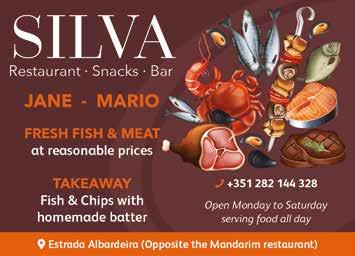











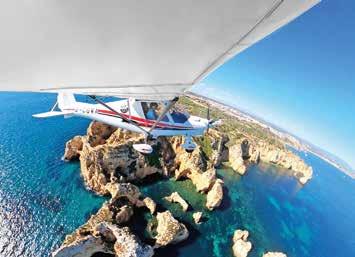


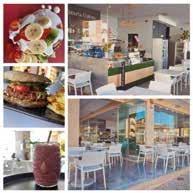











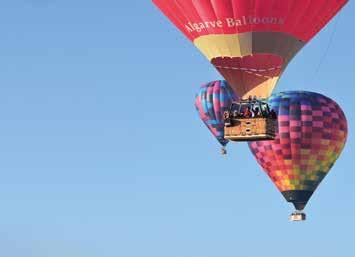

















Servicing & Repairs Visit our shop in Luz: Ebike Software Updates Equipment Shop Guided Rides Bike Rentals +351 918 502 663 info@bicabikes.com www.bicabikes.com www.algarve.fly365.co.uk 00 44 7831 439651 20min €60 | 30min €100 | 60min €180 SEE THE ALGARVE FROM THE SKY We solve your problems with your car documentation Change of foreign driving license WE LEGALISE IMPORTED VEHICLES lagos.doc23@gmail.com www.doclagos.com Have you tried defying gravity? www.algarveballoons.com | +351 91 453 2300 Providing all customers with happy moments, sweet and savory Open Tuesday to Saturday 9am to 9pm and Sunday 9am to 4pm Rua Senhora do Loreto, Lagos (former Frescos) 968 098 388 Vegan Options • Breakfast • Daily Specials • Snacks • Homemade Cakes ann@fit2lovelife.com +351 913 202 621 Follow Personal Training Women’s Health Yoga Classes Golf Fitness Be Fit to your Life! www.fit2lovelife.com Your advert would look great here ;) No contract Free design Online listing For more information call Tom: +351 919 918 733
Rooting for a greener and more fireproof Portugal
GEOTA has already planted 1 million native trees – and now they need your help to plant 2 million more.
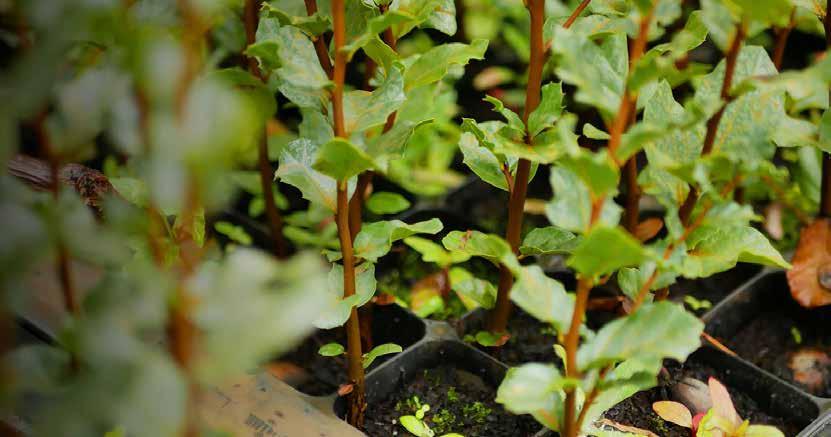
Portugal is a hot topic. This beautiful country holds some impressive records for things like long bridges, cork production and sunny days. But, sadly, it’s not always in the news for such positive reasons. Since 2010, the nation has tragically endured the burning of more than 1.5 million hectares of land, making it the most fire-affected country in Europe during the 21st century. Indeed, anybody living in the Algarve surely remembers August 2018, when Europe’s most destructive fire engulfed the Serra de Monchique.
From the ashes
Since 2019, a non-governmental environmental organisation called GEOTA (Group for the Study and Planning of Territory and Environment) has been on the ground ‘planting back better’. Through their Renature project, they have successfully planted a total of 1 million native trees in the Serra de Monchique, the Natural Park of Serra da Estrela, and the National Forest of Leiria.
GEOTA aims to not only reforest the burned areas but to simultaneously support the local communities and increase forest resilience to help ensure that it doesn’t happen again.
How can we prevent fire?
Well, it all comes down to what we plant. Around 98% of the forest affected is private or communally owned, and there is a financial incentive for local landowners and farmers to plant fast-growing trees that aren’t native to the country.
Eucalyptus, for example, comes from Australia and can be grown quickly. It is used in the construction industry and to make paper. Although perfectly fine here and there, it tends to outcompete its local neighbours for resources. These kinds of monocultures are highly flammable, and their leaves blowing in the wind help spread fire.
Bringing back the natives
It turns out that a certain kind of protective magic happens when the plants that are supposed to live here are given the opportunity to grow happily and harmoniously together. This is due to a variety of reasons:
More moisture: Native trees and plants are adapted to the local climate and soil conditions, which means they are
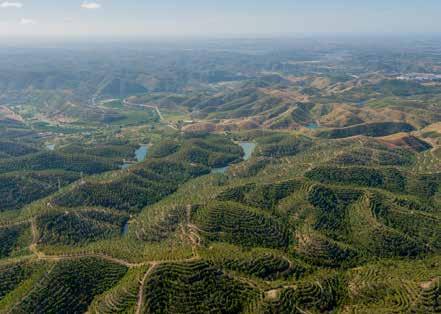
better at retaining moisture. This can create a more humid microclimate within the ecosystem, making it less prone to drying out and igniting.
Can’t see the wood for the trees: Native vegetation tends to grow in diverse and dense formations, creating natural barriers that can help slow the spread of fire. Bushy bushes can prevent flames from reaching the tree canopy, where fires can become more intense and difficult to control.
Forged in fire: Many native tree and plant species have evolved adaptations to survive and even thrive in fire-prone environments. Species like oak trees – all wrapped up in their cork jackets – are extremely fire-resistant. Other species may have specialised growth patterns or chemical compositions that make them less flammable.
Soil stop: Native plants contribute to soil health by adding organic matter, improving soil structure, and enhancing water retention. Healthy soil can act as a natural firebreak, slowing the spread of flames and reducing the intensity of wildfires.
WORDS Jake Cleaver
ENVIRONMENT 60 Tomorrow magazine - community magazine for the Algarve | www.tomorrowalgarve.com
Serra Monchique
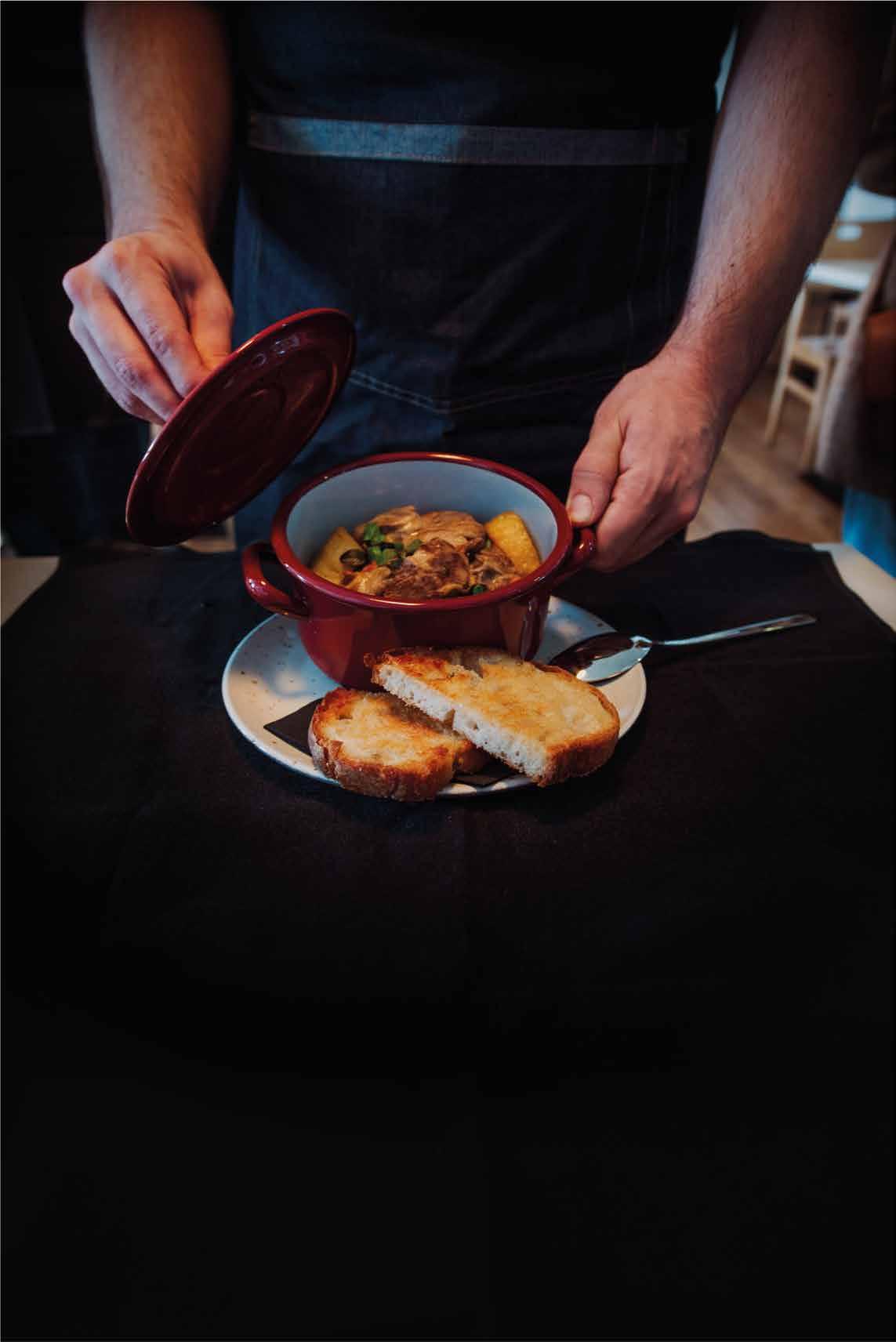
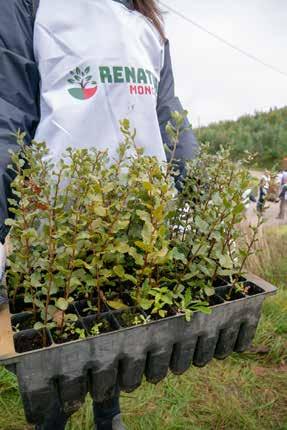
Basically, when native trees and plants grow together in symbiosis, they create a resilient ecosystem that is better equipped to withstand forest fires and recover faster from them.
Meet the locals
Throughout the various projects, GEOTA have been planting a mix of local trees, including carvalhos (oaks), sobreiros (cork oaks) and castanheiros (chestnut trees) and medronheiros (strawberry trees).
There’s been a special effort to replant the majestic carvalho-de-Monchique (Monchique oak), a tree emblematic only to the Serra de Monchique region and the Rio Mira basin. According to the Red List of Vascular Flora of Continental Portugal, it has sadly become critically endangered.
In Leiria, a city in central Portugal quite close to the coast, a pine forest – the Pinhal de Leiria – was famously planted by King Dom Dinis in the 13th century. It did not only serve to protect the king’s castle from sandstorms but also served as a barrier against the advance and degradation of the dunes.
There have been many fires over the centuries, not to mention the famous cyclone that hit Portugal in 1941, but



nothing was ever as bad as the huge fire that tragically burnt down an estimated 80% of the pine forest in 2017.
To help bring the king’s pine forest back, GEOTA has been replanting the pinheiro bravo (maritime pine) and the pinheiro manso (stone pine).
Nature’s guardians
More magic happens when nature’s symbiotic miracles are supported by people – working happily and harmoniously together, too. GEOTA has been devoted to connecting communities in that same spirit.
Throughout the Renature projects, about 700 landowners are already being supported in an intervention area of 3,000 hectares. And, to help boost the economy of the regions where the Renature projects are being carried out, the team of around 50 people are all sourced locally – as well as all the materials and plants used.
How can you help?
To continue the work started in 2019, GEOTA has set the goal of planting another 2 million trees by 2027. To do this, they are asking you to please dig as deep as you can, as your donation will help ensure that the first 250,000 trees get into the ground and start growing as soon as possible.
www.gofundme.com/f/renatureportugalgeota
ENVIRONMENT 62 Tomorrow magazine - community magazine for the Algarve | www.tomorrowalgarve.com













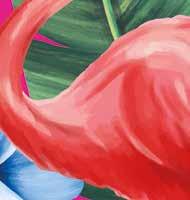
Price includes: Welcome drink, delicious bu et dinner, drinks during the meal and charity donation For more information or to buy tickets: tact@tomorrowalgarve.com | +351 961 952 743 CHARITY SAT 1 JUNE Tivoli Hotel, Lagos @ 18.30 LIVE MUSIC WITH 5 EX BAND TROPICAL DRESS CODE 70€ PER PERSON SUMMER PARTY




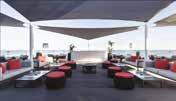
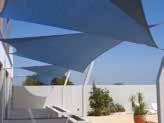

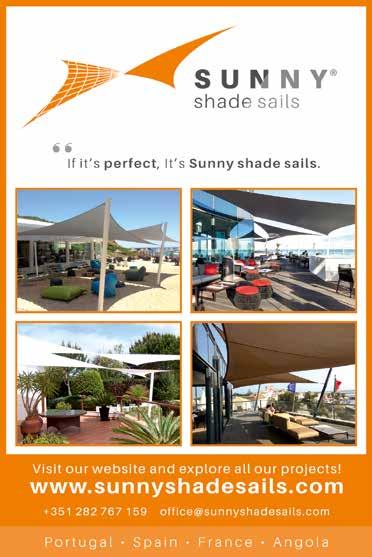

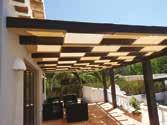









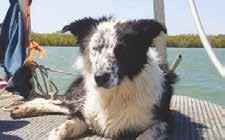

SierraSea Tours & Transfers V w (+351) 915 046 188 D www.sierrasea.com For information on the transfers and tours available please visit our website RNAVT 9493 WE CARE FOR YOUR HEALTH www.luzdoc com +351 919 869 700 TIMETABLE: WEEK FROM 9AM TO 7PM / SATURDAYS & BANK HOLIDAYS 9AM TO 2PM GENERAL / FAMILY MEDICINE AND NURCING POINT OF CARE LABORATORY OCCUPATIONAL HEALTH AESTHETIC MEDICINE PERSONALISED PHYSIOTHERAPY MEDICAL SPECIALTIES PODOLOGY ACUPUNCTURE MULTILINGUAL STAFF Emergency Advice

























































































 Tuna de Magisterio de Sevilla
Tuna de Magisterio de Sevilla



 From: Quinta Art Collective
From: Quinta Art Collective








 WORDS Marta Nogueira (Arquivo Municipal de Lagos)
WORDS Marta Nogueira (Arquivo Municipal de Lagos)

























































 1. Seara de Trigo, Raposeira 2018
2. Moinho da Torre, Budens 2021
3. Máquina escolhedeira, Museu de Vila do Bispo Soares
1. Seara de Trigo, Raposeira 2018
2. Moinho da Torre, Budens 2021
3. Máquina escolhedeira, Museu de Vila do Bispo Soares








































































 2001, Brunei
2001, Brunei









































 WORDS David Lugg
WORDS David Lugg



















































































































































































